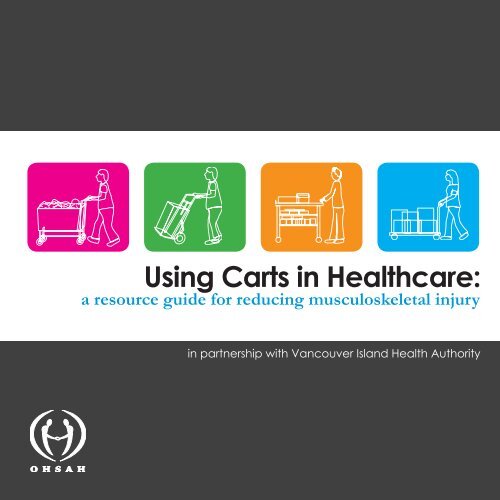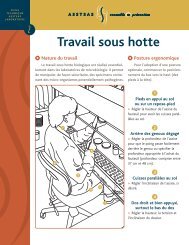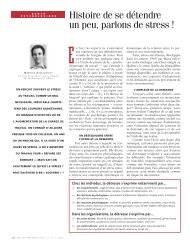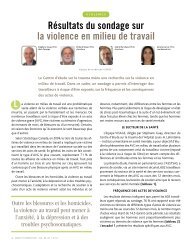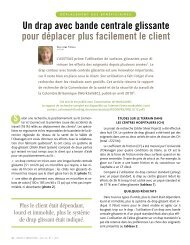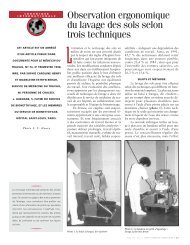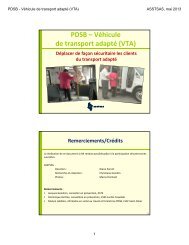Using Carts in Healthcare: a resource guide for reducing ... - Asstsas
Using Carts in Healthcare: a resource guide for reducing ... - Asstsas
Using Carts in Healthcare: a resource guide for reducing ... - Asstsas
- No tags were found...
You also want an ePaper? Increase the reach of your titles
YUMPU automatically turns print PDFs into web optimized ePapers that Google loves.
<strong>Us<strong>in</strong>g</strong> <strong>Carts</strong> <strong>in</strong> <strong>Healthcare</strong>:a <strong>resource</strong> <strong>guide</strong> <strong>for</strong> reduc<strong>in</strong>g musculoskeletal <strong>in</strong>jury<strong>in</strong> partnership with Vancouver Island Health Authority
<strong>Us<strong>in</strong>g</strong> <strong>Carts</strong> <strong>in</strong> <strong>Healthcare</strong>:a <strong>resource</strong> <strong>guide</strong> <strong>for</strong> reduc<strong>in</strong>g musculoskeletal <strong>in</strong>jury<strong>in</strong> partnership with Vancouver Island Health Authority
acknowledgmentsOHSAH is grateful to everyone who contributed to the development of <strong>Us<strong>in</strong>g</strong> <strong>Carts</strong> <strong>in</strong> <strong>Healthcare</strong>: A ResourceGuide <strong>for</strong> Reduc<strong>in</strong>g Musculoskelelal Injury (MSI).Special thanksSpecial thanks to Nanaimo Regional General Hospital, Trillium Lodge, and West Coast General Hospital <strong>for</strong>tak<strong>in</strong>g the time to implement and try some of the control measures mentioned <strong>in</strong> this book, and thanks toVancouver Island Health Authority <strong>for</strong> lead<strong>in</strong>g the process.Content review participants• Shelley Boese, Inventory/Distribution Supervisor, Nanaimo Regional General Hospital• Merle Burton, Ma<strong>in</strong>tenance, Trillium Lodge• Brian Kossey, Safety and Ergonomics Advisor, Vancouver Island Health Authority• Tracey Newlands, Manager of Occupational, Physiotherapy, and Speech Therapy, Nanaimo RegionalGeneral Hospital• Sandy Ribeyre, Central West Manager of Facilities, Ma<strong>in</strong>tenance, and Operations, Vancouver IslandHealth Authority• Dr. Dan Rob<strong>in</strong>son, Ergonomist, Rob<strong>in</strong>son Ergonomics Inc.• Claire W<strong>in</strong>field, MSIP Advisor, Vancouver Island Health AuthorityOHSAH ma<strong>in</strong> contributors• Ela<strong>in</strong>e J. Lee, Ergonomics Project Coord<strong>in</strong>ator• Nerm<strong>in</strong> Helal, Ergonomist• Chris Back, Ergonomics Program Manager• Dr. Annalee Yassi, Found<strong>in</strong>g Executive Director
who should use this <strong>guide</strong>?<strong>Us<strong>in</strong>g</strong> <strong>Carts</strong> <strong>in</strong> <strong>Healthcare</strong>: A Resource Guide <strong>for</strong> Reduc<strong>in</strong>g Musculoskeletal Injury (MSI) is <strong>for</strong> anyone who needspractical <strong>in</strong><strong>for</strong>mation on the safe use of carts <strong>in</strong> the healthcare environment. This <strong>guide</strong> focuses on us<strong>in</strong>gcarts to reduce the physical ef<strong>for</strong>t required <strong>for</strong> transport<strong>in</strong>g supplies and the risk of MSI associated withmanual materials handl<strong>in</strong>g.• Employers will f<strong>in</strong>d <strong>in</strong><strong>for</strong>mation that will help them collaborate with healthcare workers to prevent<strong>in</strong>jury related to the use of carts. This <strong>in</strong><strong>for</strong>mation will help them detect potential MSI risks andimplement effective control measures (<strong>for</strong> example, design<strong>in</strong>g or select<strong>in</strong>g suitable carts).• Workers will f<strong>in</strong>d specific health and safety <strong>in</strong><strong>for</strong>mation that will help them carry out their day-to-daytasks safely and efficiently.• Purchasers will f<strong>in</strong>d <strong>in</strong><strong>for</strong>mation to help select carts that are appropriate and effective.• Facilities ma<strong>in</strong>tenance workers will f<strong>in</strong>d <strong>in</strong><strong>for</strong>mation related to their role <strong>in</strong> prevent<strong>in</strong>g MSI <strong>in</strong> workerswho use carts.Look <strong>for</strong> opportunities to manage the risk of MSI associated with us<strong>in</strong>g carts whenever you:• design new carts• modify exist<strong>in</strong>g carts• purchase new carts• respond to <strong>in</strong>cidents related to carts• develop and implement a proactive risk management programMany of the recommendations <strong>in</strong> this <strong>guide</strong> have been developed and implemented successfully <strong>in</strong>collaboration with healthcare workers throughout BC. You can photocopy and use material from theappendices (the checklists, tools, and templates) as work<strong>in</strong>g copies at your facility.IIf you found this <strong>guide</strong> useful, be sure to check out our other ergonomic publications. Samples ofthese resouces can be downloaded from the OHSAH website (www.ohsah.bc.ca).
table of contentsPart 1: Introduction 9Key po<strong>in</strong>ts 10Terms 11Part 2: Musculoskeletal Injury 13Common signs and symptoms of MSI 14Stages of MSI 15Understand<strong>in</strong>g MSI risk factors 16Risk factors associated with manual materials handl<strong>in</strong>g (MMH) 18Risk factors associated with us<strong>in</strong>g carts 20Is there a risk of MSI associated with us<strong>in</strong>g carts <strong>in</strong> your facility? 24Part 3: Handl<strong>in</strong>g and Ma<strong>in</strong>ta<strong>in</strong><strong>in</strong>g <strong>Carts</strong> 27Safe work practices 28Work organization 31Footwear 33Cart ma<strong>in</strong>tenance 34Part 4: Purchas<strong>in</strong>g and Select<strong>in</strong>g <strong>Carts</strong> 35Cart dimensions 36Handles 37Shelves and drawers 42Casters 45Wheels 47Caster and wheel position and configuration 52Load weight and load capacity 58Brakes 61Motorized push pullers 62Part 5: Environmental Conditions 63Floors and ground cover<strong>in</strong>g 64Hallways and doorways 65Incl<strong>in</strong>es 66
table of contentsPart 6: Education and Tra<strong>in</strong><strong>in</strong>g 69Sample eduation module <strong>for</strong> MSI prevention <strong>for</strong> workers us<strong>in</strong>g carts 70Guidel<strong>in</strong>es <strong>for</strong> occupational health and safety tra<strong>in</strong><strong>in</strong>g 72Part 7: Implementation and Evaluation 73Pre-implementation risk identification and assessment 74Implementation of the control measure 76Post-implementation evaluation 77Appendices 79Appendix 1Signs and symptoms survey 80Appendix 2Risk factor identification checklist 83Appendix 3WorkSafeBC ergonomics requirements 85Appendix 4Pre-purchase checklists and flow charts 88Appendix 5Sample calculations us<strong>in</strong>g load weight and load capacity 99Appendix 6Cart identification <strong>for</strong>m (exist<strong>in</strong>g carts) 103Appendix 7Implementation <strong>guide</strong>l<strong>in</strong>e 104Appendix 8Stretch<strong>in</strong>g rout<strong>in</strong>e 105Appendix 9References 106
1IntroductionThis part <strong>in</strong>cludes the follow<strong>in</strong>g sections:• Key po<strong>in</strong>ts• Terms
key po<strong>in</strong>tsHere is a summary of the key po<strong>in</strong>ts that are covered <strong>in</strong> more detail throughout this <strong>guide</strong>:• Common signs and symptoms of MSI <strong>in</strong>clude redness, swell<strong>in</strong>g, pa<strong>in</strong>, tenderness, t<strong>in</strong>gl<strong>in</strong>g,weakness, and clums<strong>in</strong>ess.• Basic risk factors <strong>for</strong> MSI <strong>in</strong>clude <strong>for</strong>ce, repetition, awkward posture, static posture, andcontact stress.• Risk factors may also be related to manual materials handl<strong>in</strong>g (MMH), <strong>in</strong>clud<strong>in</strong>g the follow<strong>in</strong>gtasks:- lift<strong>in</strong>g, carry<strong>in</strong>g, and handl<strong>in</strong>g objects- push<strong>in</strong>g, pull<strong>in</strong>g, and manoeuvr<strong>in</strong>g carts• It is important to identify high-risk tasks and anticipate the risk factors associated with alltasks.• Reduce as many of the risk factors with<strong>in</strong> each task as possible. Risk control can be simple and<strong>in</strong>expensive.• Evaluation and worker consultation are important to ensure that implemented controlmeasures are effective and that they have a positive impact <strong>for</strong> all workers.• <strong>Carts</strong> can reduce the risk associated with MMH, if they are selected carefully and ma<strong>in</strong>ta<strong>in</strong>ed.10<strong>Us<strong>in</strong>g</strong> <strong>Carts</strong> <strong>in</strong> <strong>Healthcare</strong>: A Resource Guide <strong>for</strong> Reduc<strong>in</strong>g Musculoskeletal Injury (MSI)
termsErgonomicsErgonomics is the application of knowledge about human capabilities and limitations to the designof work, equipment, tools, work environments, and work organization to optimize human well-be<strong>in</strong>gand per<strong>for</strong>mance.Musculoskeletal <strong>in</strong>jury (MSI)The Occupational Health and Safety Regulation def<strong>in</strong>es musculoskeletal <strong>in</strong>jury (MSI) as “an <strong>in</strong>juryor disorder of the muscles, tendons, ligaments, jo<strong>in</strong>ts, nerves, blood vessels or related soft tissue<strong>in</strong>clud<strong>in</strong>g a spra<strong>in</strong>, stra<strong>in</strong> and <strong>in</strong>flammation, that may be caused or aggravated by work.” MSI issometimes also referred to as work-related musculoskeletal disorder, cumulative trauma disorder,repetitive stra<strong>in</strong> <strong>in</strong>jury, or activity-related soft tissue disorder.Some common MSIs associated with carts <strong>in</strong>clude the follow<strong>in</strong>g:• f<strong>in</strong>gers or hands caught <strong>in</strong>, on, or between a cart and another object• toes, feet, or lower legs bumped or crushed by a cart• arm, shoulder, or back stra<strong>in</strong>MSI risk factorsMSI risk factors are the physical demands of a task that contribute to the overall risk of MSI.Control measureA control measure is a solution that is implemented to elim<strong>in</strong>ate or m<strong>in</strong>imize the risk of MSI. Alwaystry to elim<strong>in</strong>ate the hazard wherever practicable. Control measures may <strong>in</strong>clude the follow<strong>in</strong>g:1. eng<strong>in</strong>eer<strong>in</strong>g controls2. adm<strong>in</strong>istrative controls3. personal protective equipment (PPE)Part One: Introduction 11
termsManual materials handl<strong>in</strong>g (MMH)Manual materials handl<strong>in</strong>g (MMH) is the transport or support of loads by hand or bodily <strong>for</strong>ce. MMHoften comb<strong>in</strong>es push<strong>in</strong>g, pull<strong>in</strong>g, lift<strong>in</strong>g, lower<strong>in</strong>g, carry<strong>in</strong>g, and hold<strong>in</strong>g. Approximately three out ofevery four Canadians whose jobs <strong>in</strong>volve MMH susta<strong>in</strong> a back <strong>in</strong>jury at some po<strong>in</strong>t <strong>in</strong> their work<strong>in</strong>glives.<strong>Carts</strong>A cart is a type of MMH device used to m<strong>in</strong>imize the physical ef<strong>for</strong>t required to per<strong>for</strong>m MMH tasks.For example, rather than lift and carry ten <strong>in</strong>dividual boxes from one location to another, a worker canuse a wheeled cart to support the weight of the boxes.Acute <strong>in</strong>juriesAcute <strong>in</strong>juries are <strong>in</strong>juries that occur immediately as a result of a s<strong>in</strong>gle traumatic event. Examples of<strong>in</strong>cidents that could cause acute <strong>in</strong>juries <strong>in</strong>clude:• items fall<strong>in</strong>g off a cart and land<strong>in</strong>g on your foot• slipp<strong>in</strong>g on a wet floor and twist<strong>in</strong>g your ankleChronic <strong>in</strong>juriesChronic <strong>in</strong>juries are <strong>in</strong>juries that develop over time as a result of repeated trauma or overuse of abody part. Symptoms develop <strong>in</strong> the affected part and the <strong>in</strong>jury may persist or get worse if nottreated properly. Examples of chronic <strong>in</strong>juries that may develop over time <strong>in</strong>clude:• shoulder, elbow, or wrist tend<strong>in</strong>itis result<strong>in</strong>g from push<strong>in</strong>g a heavy cart frequently• wrist pa<strong>in</strong> result<strong>in</strong>g from support<strong>in</strong>g the weight of objects on a dolly• back pa<strong>in</strong> result<strong>in</strong>g from push<strong>in</strong>g a loaded plat<strong>for</strong>m truck every shiftThe worst-case scenario is an <strong>in</strong>jury that leaves the worker unable to per<strong>for</strong>m his or her everydayduties and tasks, both at the workplace and elsewhere.12<strong>Us<strong>in</strong>g</strong> <strong>Carts</strong> <strong>in</strong> <strong>Healthcare</strong>: A Resource Guide <strong>for</strong> Reduc<strong>in</strong>g Musculoskeletal Injury (MSI)
2MusculoskeletalInjury (MSI)This part provides <strong>in</strong><strong>for</strong>mation onmusculoskeletal <strong>in</strong>jury (MSI). It <strong>in</strong>cludes thefollow<strong>in</strong>g sections:• Common signs and symptoms of MSI• Stages of MSI• Understand<strong>in</strong>g MSI risk factors• Risk factors associated with manualmaterials handl<strong>in</strong>g (MMH)• Risk factors associated with us<strong>in</strong>g carts• Is there a risk of MSI associated with us<strong>in</strong>gcarts <strong>in</strong> your facility?
common signs and symptoms of MSiWork-related MSI can make normal work rout<strong>in</strong>es uncom<strong>for</strong>table and even pa<strong>in</strong>ful. This can lead tostress or dissatisfaction at work, reduced productivity, an <strong>in</strong>ability to per<strong>for</strong>m some or all work duties,and even difficulty with activities at home. Early recognition of common signs and symptoms of MSIcan help prevent <strong>in</strong>juries from gett<strong>in</strong>g worse.signsSigns are th<strong>in</strong>gs you can see,such as swell<strong>in</strong>g or redness.Typical signs of MSI <strong>in</strong>clude thefollow<strong>in</strong>g:• redness of the sk<strong>in</strong>• swell<strong>in</strong>g around the <strong>in</strong>juredarea• loss of full, normal jo<strong>in</strong>tmovementsymptomsSymptoms are th<strong>in</strong>gs you canfeel but cannot see, such asnumbness, t<strong>in</strong>gl<strong>in</strong>g, or pa<strong>in</strong>.Typical symptoms of MSI <strong>in</strong>cludethe follow<strong>in</strong>g:• clums<strong>in</strong>ess• weakness• tenderness• t<strong>in</strong>gl<strong>in</strong>g• numbness• heav<strong>in</strong>ess• heat or burn<strong>in</strong>g• pa<strong>in</strong> (dull, sharp, orshoot<strong>in</strong>g)14<strong>Us<strong>in</strong>g</strong> <strong>Carts</strong> <strong>in</strong> <strong>Healthcare</strong>: A Resource Guide <strong>for</strong> Reduc<strong>in</strong>g Musculoskeletal Injury (MSI)
stages of msiMSI signs and symptoms tend to follow the stages described <strong>in</strong> Table 2.1. Some MSIs progress rapidlyfrom early to late stages. A worker who experiences early signs or symptoms of MSI should reportthem to a supervisor or manager immediately and fill out an <strong>in</strong>jury or <strong>in</strong>cident report <strong>for</strong>m. If signs orsymptoms persist <strong>for</strong> more than a few days, the worker should see a medical professional.Intensity and frequency of signs and symptomsEncourag<strong>in</strong>g workers to report earlysigns and symptoms of MSI is animportant part of MSI prevention. Asurvey can help establish how manyworkers and which workers areexperienc<strong>in</strong>g signs and symptomsthat they have not yet consideredsevere enough to report. SeeAppendix 1 <strong>for</strong> a sample survey.Ach<strong>in</strong>gor fatiguemay bepresent whileper<strong>for</strong>m<strong>in</strong>g tasksat work but lessens ordisappears with rest (<strong>for</strong>example, dur<strong>in</strong>g rest breaks,overnight, or on weekends).No effects on work per<strong>for</strong>mance areusually noticed, nor are there any othersigns of a problem. This stage may last <strong>for</strong>weeks or months.Pa<strong>in</strong>, ach<strong>in</strong>g, andfatigue may cont<strong>in</strong>ueafter complet<strong>in</strong>g tasksat work and may bepresent at home. Signs ofMSI may also be present.Signs and symptoms maynot disappear with rest.Per<strong>for</strong>mance of activitiesmay be somewhataffected. This stage maylast <strong>for</strong> several months.Pa<strong>in</strong>, ach<strong>in</strong>g, andfatigue may bepresent even whenthe affected bodypart is rested. Signsof MSI are present.Per<strong>for</strong>mance of workduties and sleep aresignificantly affected.This stage may last <strong>for</strong>months or years.Early stage Middle stage Late stageTable 2.1 Stages of MSITimePart Two: Muscoloskeletal Injury (MSI) 15
understand<strong>in</strong>g msi risk factorsUnderstand<strong>in</strong>g risk factors and identify<strong>in</strong>g where they might occur is the first step <strong>in</strong> prevent<strong>in</strong>g MSI.When assess<strong>in</strong>g the degree of risk, it is important to ask three basic questions:1. What is the <strong>in</strong>tensity or magnitude of exposure to the risk factor (how much)?2. What is the frequency of exposure to the risk factor (how often)?3. What is the duration of exposure to the risk factor (how long)?If a task presents high levels of any one risk factor or presents multiple risk factors, the level of riskcan <strong>in</strong>crease greatly. This section describes the follow<strong>in</strong>g risk factors:• <strong>for</strong>ce• repetition• awkward posture• static posture• contact stressForceForceful exertion <strong>in</strong>creases the body’s energy demands and physically stresses the muscles, tendons,ligaments, and jo<strong>in</strong>ts, which <strong>in</strong>creases the risk of <strong>in</strong>jury. For example, push<strong>in</strong>g a heavy cart over anobstacle such as a hose or electrical cord requires <strong>for</strong>ceful exertion.RepetitionA repetitive task is a task that uses the same muscles repeatedly. For example, cont<strong>in</strong>ually turn<strong>in</strong>g acart to navigate through a cluttered hall can be repetitive.Awkward postureAwkward posture occurs when the body has to work <strong>in</strong> a position that is not considered neutral.Neutral postures are those <strong>in</strong> which the muscles, tendons, ligaments, and jo<strong>in</strong>ts function optimallyand require the least amount of ef<strong>for</strong>t to ma<strong>in</strong>ta<strong>in</strong>. Awkward posture <strong>in</strong>creases the amount of stresson muscles, tendons, ligaments, and jo<strong>in</strong>ts; it is of greatest concern when it is susta<strong>in</strong>ed <strong>for</strong> prolongedperiods or comb<strong>in</strong>ed with other risk factors. What is considered awkward is different <strong>for</strong> each bodypart.16<strong>Us<strong>in</strong>g</strong> <strong>Carts</strong> <strong>in</strong> <strong>Healthcare</strong>: A Resource Guide <strong>for</strong> Reduc<strong>in</strong>g Musculoskeletal Injury (MSI)
Understand<strong>in</strong>g msi risk factorsStatic postureStatic posture is a body position held <strong>for</strong> aprolonged period. The level of risk that staticposture presents depends on the level of muscularexertion and the posture itself. For example,bend<strong>in</strong>g <strong>for</strong>ward to push a plat<strong>for</strong>m truck with ahandle that is too low places the back <strong>in</strong> a static (aswell as awkward) posture. Muscles that are exert<strong>in</strong>g<strong>for</strong>ce may tire more quickly <strong>in</strong> a static posture thanwhen mov<strong>in</strong>g.Contact stressContact stress occurs when body parts come<strong>in</strong>to contact with hard or sharp objects, whichconcentrates <strong>for</strong>ce on the underly<strong>in</strong>g tissues. This<strong>in</strong>terferes with normal blood flow and nervefunction. This type of stress can result <strong>in</strong> <strong>in</strong>jury totissues beneath the sk<strong>in</strong>. For example, handl<strong>in</strong>g theedge of a cart because it has no handle can causecontact stress on the hands.Figure 2.1 Lead<strong>in</strong>g a cart by pull<strong>in</strong>g with one armcan place the shoulder <strong>in</strong> an awkward posture.Part Two: Muscoloskeletal Injury (MSI) 17
isk factors associated with manual materials handl<strong>in</strong>g(MMH)Manual materials handl<strong>in</strong>g (MMH) <strong>in</strong>cludes push<strong>in</strong>g, pull<strong>in</strong>g, lift<strong>in</strong>g, lower<strong>in</strong>g, carry<strong>in</strong>g, and hold<strong>in</strong>gloads. These activities may present any of the basic risk factors: <strong>for</strong>ce, repetition, awkward posture,static posture, and contact stress. This section discusses risk factors related to handl<strong>in</strong>g materialswithout the use of carts.ForceThe amount of <strong>for</strong>ce exerted dur<strong>in</strong>g MMH depends on the follow<strong>in</strong>g:• worker characteristics (body weight and height)• load characteristics (weight, size, and shape)• task requirements (amount of <strong>for</strong>ce applied and duration of exertion)• handl<strong>in</strong>g technique (us<strong>in</strong>g one or two hands; foot distance and stance)• environmental conditions (type of floor surface)Forceful exertion is most likely to affect the back, shoulders, wrists, and hands.RepetitionRepetition may be a risk factor dur<strong>in</strong>g MMH if similar tasks are repeated throughout the day suchas fold<strong>in</strong>g l<strong>in</strong>en or stock<strong>in</strong>g shelves. These tasks may affect the worker’s back, shoulders, and wrists.Tasks that require kneel<strong>in</strong>g, squatt<strong>in</strong>g, or crouch<strong>in</strong>g may also affect the legs. The amount of risk thatrepetition present depends on the follow<strong>in</strong>g:• frequency of tasks• amount of rest between tasks• body parts usedAwkward postureMMH may result <strong>in</strong> awkward posture if the task <strong>in</strong>volves reach<strong>in</strong>g or twist<strong>in</strong>g. For example, bend<strong>in</strong>gat the waist to lift someth<strong>in</strong>g from the ground may cause an awkward back posture; pull<strong>in</strong>g a boxfrom an overhead shelf may cause an awkward shoulder posture. MMH may also result <strong>in</strong> awkwardpostures of the neck, wrists, and hands. Awkward posture may be affected by the follow<strong>in</strong>g:• worker characteristics (body height)• load characteristics (weight, size, shape, and handles)18<strong>Us<strong>in</strong>g</strong> <strong>Carts</strong> <strong>in</strong> <strong>Healthcare</strong>: A Resource Guide <strong>for</strong> Reduc<strong>in</strong>g Musculoskeletal Injury (MSI)
isk factors associated with manual materials handl<strong>in</strong>g(MMH)• task requirements (amount of <strong>for</strong>ce applied and duration of exertion)• handl<strong>in</strong>g technique (bend<strong>in</strong>g at the lower back or the knees and hips; us<strong>in</strong>g one or two hands;foot distance and stance)• environmental conditions (heights of shelves or obstacles)Static postureStatic posture may be a risk factor dur<strong>in</strong>g MMH if positions are held <strong>for</strong> a long time (<strong>for</strong> example,when carry<strong>in</strong>g a load over a long distance). Static posture is most likely to affect the back, shoulders,wrists, and hands. Static posture may be affected by the follow<strong>in</strong>g:• duration the position is held• amount of <strong>for</strong>ce appliedContact stressContact stress may be a risk factor dur<strong>in</strong>g MMH if the object be<strong>in</strong>g handled has hard or sharp edges(<strong>for</strong> example, handles cut <strong>in</strong>to the side of a cardboard box). Contact stress may also be a risk factor ifkneel<strong>in</strong>g or rest<strong>in</strong>g the elbows on a hard surface is required. Contact stress is most likely to affect thehands, elbows, and knees.Part Two: Muscoloskeletal Injury (MSI) 19
isk factors associated with us<strong>in</strong>g carts<strong>Carts</strong> are often used to m<strong>in</strong>imize the physical ef<strong>for</strong>t required to per<strong>for</strong>m MMH tasks. For example,rather than lift and carry heavy equipment from one location to another, a worker may use a cart tomove them.Although us<strong>in</strong>g a cart is a control measure that reduces the amount of carry<strong>in</strong>g required, it is stillconsidered an MMH task. Risk factors associated with MMH are not elim<strong>in</strong>ated by us<strong>in</strong>g a cart, butthey can be m<strong>in</strong>imized by select<strong>in</strong>g the appropriate cart <strong>for</strong> the task and us<strong>in</strong>g it properly.Load<strong>in</strong>g a cart <strong>in</strong>volves lift<strong>in</strong>g, lower<strong>in</strong>g, and carry<strong>in</strong>g tasks.Manoeuvr<strong>in</strong>g a cart <strong>in</strong>volves push<strong>in</strong>g and pull<strong>in</strong>g tasks. Theseactivities may present the same risk factors as any other MMHactivity: <strong>for</strong>ce, repetition, awkward posture, static posture, andcontact stress. This section discusses these risk factors as theyrelate to the use of carts <strong>for</strong> handl<strong>in</strong>g materials.Although us<strong>in</strong>g a cart isa control measure, it isstill a manual materialshandl<strong>in</strong>g task thatpresents some risk of<strong>in</strong>jury.ForceHandl<strong>in</strong>g carts may require <strong>for</strong>ceful exertion when load<strong>in</strong>g, unload<strong>in</strong>g, push<strong>in</strong>g, pull<strong>in</strong>g ormanoeuvr<strong>in</strong>g. The amount of <strong>for</strong>ce exerted depends on the follow<strong>in</strong>g:• cart characteristics (weight, size, location of handles, and type of casters)• load characteristics (weight, size, and shape)• handl<strong>in</strong>g technique (us<strong>in</strong>g one or two hands)• task requirements (distance travelled and method of load<strong>in</strong>g and unload<strong>in</strong>g)• environmental conditions (type of floor surface, and <strong>in</strong>cl<strong>in</strong>es or obstacles)RepetitionRepeated handl<strong>in</strong>g and manoeuvr<strong>in</strong>g of carts may result <strong>in</strong> repetitive shoulder and wrist motions.Load<strong>in</strong>g and unload<strong>in</strong>g a large amount of materials from carts may also result <strong>in</strong> repetitive motions.20<strong>Us<strong>in</strong>g</strong> <strong>Carts</strong> <strong>in</strong> <strong>Healthcare</strong>: A Resource Guide <strong>for</strong> Reduc<strong>in</strong>g Musculoskeletal Injury (MSI)
isk factors associated with us<strong>in</strong>g cartsAwkward postureThe positions of handles and shelves on carts have the greatest <strong>in</strong>fluence on worker posture.Awkward posture may be affected by the follow<strong>in</strong>g:• cart characteristics (size, design and location of handles, and location of shelves)• load characteristics (size and shape, and whether the load obstructs the worker’s view)• location on the cart where <strong>for</strong>ce is applied• method of push<strong>in</strong>g or pull<strong>in</strong>g• ability of workers to see over or around the cart when push<strong>in</strong>gStatic posturePush<strong>in</strong>g, pull<strong>in</strong>g, or steady<strong>in</strong>g carts over long distances or <strong>for</strong> long durations may result <strong>in</strong> staticpostures of the back, neck, shoulders, wrists, and hands. Static posture may be affected by thefollow<strong>in</strong>g:• duration the position is held• amount of <strong>for</strong>ce appliedContact stressContact stress may be a risk factor with carts thathave hard or sharp edges such as a square corneron the cart handle. Contact stress may also be arisk factor if workers kneel or rest their elbows (<strong>for</strong>example, to access the cart load). When workers areus<strong>in</strong>g carts, contact stress is most likely to affect the hands,<strong>for</strong>earms, elbows, and knees.Figure 2.2 Square or sharp-edged carthandles may present a risk of contact stress.Other elements that <strong>in</strong>fluence risk factorsOther elements that may affect the level of risk associated with us<strong>in</strong>g carts are divided <strong>in</strong>to thefollow<strong>in</strong>g categories: worker characteristics, choices made by workers, cart and equipment design,organization of work, and environmental conditions.Part Two: Muscoloskeletal Injury (MSI) 21
isk factors associated with us<strong>in</strong>g cartsWorker characteristics• height and weight• age• gender• strength• posture• physical fitness• history of <strong>in</strong>juryChoices made by workers• equipment selection• selection of procedures,techniques, and postures• education and tra<strong>in</strong><strong>in</strong>gCart and equipment design• stability• size and weight• height of handles• orientation of handles (<strong>for</strong>example, horizontal orvertical)• type of handles (<strong>for</strong> example,square, rounded, or conical)• design and configuration of casters and wheels (<strong>for</strong> example, number of wheels and swivel orrigid casters)Organization of work• work recovery cycles• task variability• work rateTask characteristicsVarious elements can <strong>in</strong>fluence risk factors<strong>in</strong>clud<strong>in</strong>g task characteristics. Some of the<strong>in</strong>fluences are as follows:• distance the cart is moved• <strong>for</strong>ce required to start mov<strong>in</strong>g the cart,keep it mov<strong>in</strong>g, or stop it• direction and nature of movement(navigation requirements)• duration and frequency of push<strong>in</strong>g andpull<strong>in</strong>g tasks• relationship of push<strong>in</strong>g and pull<strong>in</strong>g tasksto other job activities• types of materials loaded onto andunloaded from the cart• tim<strong>in</strong>g and sequence of load<strong>in</strong>g andunload<strong>in</strong>g requirements22<strong>Us<strong>in</strong>g</strong> <strong>Carts</strong> <strong>in</strong> <strong>Healthcare</strong>: A Resource Guide <strong>for</strong> Reduc<strong>in</strong>g Musculoskeletal Injury (MSI)
isk factors associated with us<strong>in</strong>g cartsEnvironmental conditions• characteristics of surfaces (<strong>for</strong> example, the types of floor<strong>in</strong>g and floor transitions)• <strong>in</strong>cl<strong>in</strong>es• hazards (<strong>for</strong> example, dirt, garbage, water, raised door frames, and other obstacles)• temperature• light<strong>in</strong>gPart Two: Muscoloskeletal Injury (MSI) 23
is there a risk of msi associate d with us<strong>in</strong>g carts <strong>in</strong> yourfacility?Employers should follow this seven-step ergonomics process to elim<strong>in</strong>ate or m<strong>in</strong>imize risks of MSIassociated with us<strong>in</strong>g carts.Step 1. ConsultationDur<strong>in</strong>g each step, consult with your:• Jo<strong>in</strong>t Occupational Health and Safety Committee (or worker health and safety representative)• Health and Safety Department (<strong>for</strong> example, an occupational health and safety advisor orergonomist)• workers, who can help identify concerns and contribute to purchas<strong>in</strong>g decisions related tocartsYou are not expected to consult with every worker. Select a representative sample of workers whocarry out the work be<strong>in</strong>g assessed, <strong>in</strong>clud<strong>in</strong>g workers with signs or symptoms of MSI. Consultationmay also <strong>in</strong>clude managers, supervisors, first aid attendants, and union representatives.Step 2. EducationEducate workers so that they can do the follow<strong>in</strong>g:• identify risk factors associated with MMH tasks and us<strong>in</strong>g carts• recognize early signs and symptoms of MSI• recognize the potential health effects of MSIStep 3. Risk identificationIdentify the MMH tasks and cart-handl<strong>in</strong>g tasks that pose a risk of MSI, and identify the risk factorsassociated with those tasks. See Appendix 2 <strong>for</strong> a risk factor identification checklist.Step 4. Risk assessmentAssess identified risk factors to determ<strong>in</strong>e the degree of risk to workers. To determ<strong>in</strong>e the degreeof risk, ask the three basic questions (see page 16) relat<strong>in</strong>g to <strong>in</strong>tensity of exposure (how much?),duration of exposure (how often?), and frequency of exposure (how long?) .24<strong>Us<strong>in</strong>g</strong> <strong>Carts</strong> <strong>in</strong> <strong>Healthcare</strong>: A Resource Guide <strong>for</strong> Reduc<strong>in</strong>g Musculoskeletal Injury (MSI)
is there a risk of msi associated with us<strong>in</strong>g carts <strong>in</strong> yourfacility?Step 5. Risk controlRisk control measures generally fall <strong>in</strong>to one of three categories listed below. Whenever possible,eng<strong>in</strong>eer<strong>in</strong>g controls or adm<strong>in</strong>istrative controls should be used first to elim<strong>in</strong>ate or m<strong>in</strong>imize exposureto the risk factors. If those types of control measures are not feasible, perosnal protective equipment(PPE) can be considered as a control measure.1. Eng<strong>in</strong>eer<strong>in</strong>g controlsCan you physically modify the equipment or environment? For example, modify cart handles toallow taller and shorter workers to use them com<strong>for</strong>tably.2. Adm<strong>in</strong>istrative controlsDoes the task need to be done (elim<strong>in</strong>ation)? Is there a different approach to achieve the sameobjective (substitution)? For example, <strong>in</strong>stead of hav<strong>in</strong>g supplies delivered to a central receiv<strong>in</strong>garea to be distributed by your facility staff, have the supplier deliver them directly to the wardswhere they are needed. Can the work be organized or per<strong>for</strong>med differently? For example, usejob rotation to reduce each worker’s duration of exposure to a specific risk, or improve worktechniques so that workers use different body parts dur<strong>in</strong>g shifts.3. Personal protective equipment (PPE)Personal protective equipment should only be used as a last resort, when eng<strong>in</strong>eer<strong>in</strong>g oradm<strong>in</strong>istrative controls are not practicable. For example, ensure that workers wear appropriatefootwear to prevent slipp<strong>in</strong>g when manoeuvr<strong>in</strong>g carts; and wear gloves to protect aga<strong>in</strong>stcontact stress when push<strong>in</strong>g.Step 6. Tra<strong>in</strong><strong>in</strong>gTra<strong>in</strong> workers to use the control measures to make their jobs safer.Step 7. EvaluationConduct an evaluation <strong>in</strong> any of the follow<strong>in</strong>g <strong>in</strong>stances:• after implement<strong>in</strong>g control measures (<strong>in</strong>clud<strong>in</strong>g the use of carts to control risks associatedwith MMH) — to determ<strong>in</strong>e their effectiveness at m<strong>in</strong>imiz<strong>in</strong>g the risk of exposure to MSI• whenever workloads or processes change — to assess changes <strong>in</strong> the risk of MSI• whenever an <strong>in</strong>jury or other <strong>in</strong>cident occurs — to prevent reoccurrencePart Two: Muscoloskeletal Injury (MSI) 25
3Handl<strong>in</strong>g andMa<strong>in</strong>ta<strong>in</strong><strong>in</strong>g <strong>Carts</strong>This part provides <strong>in</strong><strong>for</strong>mation that willhelp m<strong>in</strong>imize the risk of MSI when us<strong>in</strong>gcarts. It <strong>in</strong>cludes the follow<strong>in</strong>g sections:• Safe work practices• Work organization• Footwear• Cart ma<strong>in</strong>tenanceThe first three sections describe potentialcontrol measures <strong>for</strong> elim<strong>in</strong>at<strong>in</strong>g orm<strong>in</strong>imiz<strong>in</strong>g risk factors. Implementthe control measures that best fit yourneeds. See Appendix 2 <strong>for</strong> a risk factoridentification checklist that will help youdeterm<strong>in</strong>e which aspects of cart use areexpos<strong>in</strong>g workers to risk factors <strong>for</strong> MSI.See Appendix 4 <strong>for</strong> a pre-purchase checklistthat will help you make <strong>in</strong><strong>for</strong>med decisionswhen purchas<strong>in</strong>g new carts.
safe work practicesGood body mechanics can help workers use less <strong>for</strong>ce to carry out tasks and prevent awkwardpostures, both of which will reduce the risk of MSI. This section <strong>in</strong>cludes safe work practices that willhelp promote good body mechanics when push<strong>in</strong>g and pull<strong>in</strong>g carts.xWorkers should consider the follow<strong>in</strong>g recommendations <strong>for</strong> push<strong>in</strong>g and pull<strong>in</strong>g carts:• Plan your route be<strong>for</strong>e mov<strong>in</strong>g the load.• Push rather than pull whenever possible.Figure 3.1 Push<strong>in</strong>g is generally safer than pull<strong>in</strong>g. Pull<strong>in</strong>g puts more stra<strong>in</strong> on the lower back and shoulders.• Bend your knees slightly and move the load by shift<strong>in</strong>g your weight. Move the load with yourwhole body by walk<strong>in</strong>g <strong>for</strong>ward, rather than plant<strong>in</strong>g your feet and push<strong>in</strong>g with your armsonly.• Keep your elbows close to your body. Keep your hands at or slightly below elbow height. Keepyour feet shoulder width apart.28<strong>Us<strong>in</strong>g</strong> <strong>Carts</strong> <strong>in</strong> <strong>Healthcare</strong>: A Resource Guide <strong>for</strong> Reduc<strong>in</strong>g Musculoskeletal Injury (MSI)
xFigure 3.2 Keep<strong>in</strong>g your elbows close to your body will help prevent shoulder stra<strong>in</strong>.• Tighten your abdom<strong>in</strong>al muscles slightly be<strong>for</strong>e beg<strong>in</strong>n<strong>in</strong>g to push. You should be able tobreathe and talk, but ma<strong>in</strong>ta<strong>in</strong> some tightness <strong>in</strong> your abdomen xto help stabilize your lowerback.• Face the cart. Po<strong>in</strong>t your toes <strong>in</strong> the direction you are mov<strong>in</strong>g to avoid twist<strong>in</strong>g your back.• Always use two hands when push<strong>in</strong>g or pull<strong>in</strong>g.Figure 3.3 Fac<strong>in</strong>g the cart and push<strong>in</strong>g with two hands rather than pull<strong>in</strong>g with one arm will help prevent shoulderstra<strong>in</strong>.• Put one foot <strong>in</strong> front of the other. Shift your body weight from the back leg to the front leg tostart mov<strong>in</strong>g the cart.• Take small steps when turn<strong>in</strong>g corners to avoid twist<strong>in</strong>g your back.• Keep your body close to the cart.• Stand upright while push<strong>in</strong>g.safe work practicesPart Three: Handl<strong>in</strong>g and Ma<strong>in</strong>ta<strong>in</strong><strong>in</strong>g <strong>Carts</strong> 29
xFigure 3.4 Stand<strong>in</strong>g upright while push<strong>in</strong>g will help prevent an awkward static posture.• Use smooth motions; avoid jerky movements.• Grasp the handles of the cart to avoid awkward hand postures associated with gripp<strong>in</strong>g thecorners of the cart.• Avoid lean<strong>in</strong>g aga<strong>in</strong>st the edge of the cart or push<strong>in</strong>g it with your knees or thighs.• Change your grip by vary<strong>in</strong>g between palms up and palms down, as well as alternat<strong>in</strong>g betweenhorizontal and vertical grips.• Alternate work<strong>in</strong>g positions to avoid overus<strong>in</strong>g any s<strong>in</strong>gle muscle or group of muscles.• Ma<strong>in</strong>ta<strong>in</strong> clear visibility when push<strong>in</strong>g the cart. Poor visibility may cause you to twist or useawkward postures. Do not pile items so they <strong>in</strong>terfere with visibility. A maximum load heightof 140 cm (55 <strong>in</strong>.) will accommodate most workers; otherwise the cart should be designed <strong>for</strong>pull<strong>in</strong>g or <strong>for</strong> two workers to push from the sides.• Shift your body weight from the front leg to the back leg to stop mov<strong>in</strong>g the cart.safe work practicesFigure 3.5 If clear visibility is not possible, usea cart designed <strong>for</strong> two workers to push from thesides.30<strong>Us<strong>in</strong>g</strong> <strong>Carts</strong> <strong>in</strong> <strong>Healthcare</strong>: A Resource Guide <strong>for</strong> Reduc<strong>in</strong>g Musculoskeletal Injury (MSI)
work organizationThe way <strong>in</strong> which work is organized <strong>in</strong>fluences the amount of <strong>for</strong>ce exerted, the postures required,the duration of tasks, and the rate of repetition of tasks. Workers should consider the follow<strong>in</strong>ggeneral <strong>guide</strong>l<strong>in</strong>es to reduce the risk of MSI associated with manual materials handl<strong>in</strong>g:• Make several smaller, lighter trips when mov<strong>in</strong>g materials, rather than one large, heavy trip.• Alternate or elim<strong>in</strong>ate tasks to decrease the frequency of handl<strong>in</strong>g carts.• Pace yourself when per<strong>for</strong>m<strong>in</strong>g repetitive tasks.• Store items between knee and shoulder height whenever possible. Store frequently used itemsat approximately waist height.Job rotationRotate workers through a variety of tasks or duties to help vary postures, to reduce exposure tostressful tasks, and to reduce exposure to risk factors (as well as prevent boredom). Employers andworkers should consider the follow<strong>in</strong>g job rotation recommendations:• Vary tasks such as handl<strong>in</strong>g carts and paperwork throughout the day.• Alternate between tasks that call <strong>for</strong> stand<strong>in</strong>g or walk<strong>in</strong>g and tasks that allow sitt<strong>in</strong>g.• Rotate workers through the heaviest push<strong>in</strong>g and pull<strong>in</strong>g tasks to reduce the risk to any oneworker.Stretch<strong>in</strong>gStretch<strong>in</strong>g improves blood circulation through the muscles. It may help relieve muscle tension,develop flexibility, and <strong>in</strong>crease body awareness. Workers should stretch on a regular basis throughoutthe day (especially if they are work<strong>in</strong>g <strong>in</strong> static postures), not just when they feel muscle tension ordiscom<strong>for</strong>t. For a stretch<strong>in</strong>g rout<strong>in</strong>e, look <strong>for</strong> the OHSAH Stretch It Out! poster, which may bedisplayed <strong>in</strong> your facility, or see Appendix 8 <strong>for</strong> a reproduction of this poster.Stretch<strong>in</strong>g is only one component of <strong>in</strong>jury prevention. General fitness, <strong>in</strong>clud<strong>in</strong>g aerobic exercise andmuscle strengthen<strong>in</strong>g, is also important. Be<strong>for</strong>e beg<strong>in</strong>n<strong>in</strong>g a stretch<strong>in</strong>g or fitness rout<strong>in</strong>e, consult withyour doctor, especially if you have an exist<strong>in</strong>g <strong>in</strong>jury or condition.Part Three: Handl<strong>in</strong>g and Ma<strong>in</strong>ta<strong>in</strong><strong>in</strong>g <strong>Carts</strong> 31
work organizationWorkers should consider the follow<strong>in</strong>g stretch<strong>in</strong>g recommendations:• Warm up first by slowly sw<strong>in</strong>g<strong>in</strong>g your arms and mov<strong>in</strong>g your legs <strong>for</strong> about 20–30 seconds.• Stretch <strong>for</strong> a few m<strong>in</strong>utes be<strong>for</strong>e start<strong>in</strong>g work to prepare your muscles <strong>for</strong> work.• Hold each stretch <strong>for</strong> 20–30 seconds.• Stretch muscles that are be<strong>in</strong>g used <strong>for</strong> a particular job or task.• Stretch only as far as is com<strong>for</strong>table. Stretch<strong>in</strong>g should not hurt.• If you feel pa<strong>in</strong>, stop the stretch. If the pa<strong>in</strong> persists, consult with your facility’s first aidattendant or your doctor.• Always stretch us<strong>in</strong>g slow and controlled motions. Never bounce or stretch rapidly.Rest breaks and micro-pausesWorkers should take rest breaks and stretch regularly throughout the day to prevent fatigue and givemuscles a chance to recover. Take frequent micro-pauses of 10–15 seconds. Dur<strong>in</strong>g micro-pauses,change your posture and stretch briefly. A micro-pause stretch is shorter <strong>in</strong> duration than a normalstretch but is still beneficial. It is also important to take longer breaks when you feel fatigued or yourmuscles are sore.32<strong>Us<strong>in</strong>g</strong> <strong>Carts</strong> <strong>in</strong> <strong>Healthcare</strong>: A Resource Guide <strong>for</strong> Reduc<strong>in</strong>g Musculoskeletal Injury (MSI)
footwearFootwear may affect a worker’s ability to use a cart safely. For example, footwear with poor or worntreads may <strong>in</strong>crease the likelihood of slipp<strong>in</strong>g. Footwear should provide enough cushion<strong>in</strong>g andsupport to relieve stress on the back and legs. Footwear should fit properly and have non-slip soles.Tips <strong>for</strong> buy<strong>in</strong>g footwearConsider these <strong>guide</strong>l<strong>in</strong>es when buy<strong>in</strong>g footwear:• Buy footwear late <strong>in</strong> the afternoon when your feet are swollen and at their maximum size.• Br<strong>in</strong>g along an old pair of work shoes to compare.• If you wear orthotics, br<strong>in</strong>g them along and try on the shoes with the orthotics <strong>in</strong>serted.• If your feet are different sizes, buy shoes to fit the larger foot.• Shoes should fit snugly without be<strong>in</strong>g too tight. There should be about 1.25 cm (0.5 <strong>in</strong>.) ofroom between your big toe and the end of the shoe.• Ensure that the footwear meets workplace standards [<strong>for</strong> example, local policies orWorkSafeBC (the Workers’ Compensation Board) requirements].Wear and tearThe frequency with which footwear needs to be replaced depends on how fast wear and tear occurs.The slip resistance of the outsoles may start to decl<strong>in</strong>e after the shoes are worn <strong>for</strong> the first time.Over time, the outsoles will deteriorate and the midsoles will break down and lose their cushion<strong>in</strong>gcapabilities.Preferred outsoles <strong>in</strong>clude v<strong>in</strong>yl with neoprene and supple rubber. If walk<strong>in</strong>g is required <strong>in</strong> wet areas,use shoes with pronounced tread; hard-soled shoes with shallow tread are not recommended.Figure 3.6 Footwear should meet any applicableworkplace standards and be constructed of durablematerials.Part Three: Handl<strong>in</strong>g and Ma<strong>in</strong>ta<strong>in</strong><strong>in</strong>g <strong>Carts</strong> 33
cart ma<strong>in</strong>tenanceRegular cart ma<strong>in</strong>tenance will help ensure that all worn or broken parts are replaced <strong>in</strong> an efficient andtimely manner. Proper ma<strong>in</strong>tenance and use of a cart will extend its life and make it more effectiveand safer.Cart ma<strong>in</strong>tenance should <strong>in</strong>clude the follow<strong>in</strong>g components:• identification of carts• regularly scheduled preventive ma<strong>in</strong>tenance• a clear procedure <strong>for</strong> identify<strong>in</strong>g and labell<strong>in</strong>g damaged or malfunction<strong>in</strong>g (out-of-service)equipment• timely repair and replacement of damaged equipmentIdentificationAll carts from each department should be identified. The make, model, supplier, and supplier support(<strong>for</strong> example, regular ma<strong>in</strong>tenance) <strong>in</strong><strong>for</strong>mation should be placed <strong>in</strong> a location that is accessible to allworkers. See Appendix 6 <strong>for</strong> a usable cart identification <strong>for</strong>m.Preventive ma<strong>in</strong>tenance programEstablish a regularly scheduled preventive ma<strong>in</strong>tenance program, with <strong>in</strong>put from equipmentmanufacturers. Preventive ma<strong>in</strong>tenance should <strong>in</strong>clude the follow<strong>in</strong>g:• Clean wheels and bear<strong>in</strong>gs on hand carts and other mechanical aids.• Lubricate casters and wheels as necessary.• Monitor tread wear, corrosion, and other changes that might b<strong>in</strong>d the wheels and <strong>in</strong>crease the<strong>for</strong>ces required to move the carts.• Replace worn or defective wheels and casters.• Check that all mechanical aids are work<strong>in</strong>g efficiently (<strong>for</strong> example, brakes or directional locks).• Ma<strong>in</strong>ta<strong>in</strong> tire pressure <strong>in</strong> pneumatic tires.Out-of-service cartsEstablish an “out-of-service” policy <strong>for</strong> tagg<strong>in</strong>g equipment that does not work. Workers should reportout-of-service carts immediately to supervisors and ma<strong>in</strong>tenance workers. Out-of-service equipmentmust be repaired be<strong>for</strong>e be<strong>in</strong>g used aga<strong>in</strong>.34<strong>Us<strong>in</strong>g</strong> <strong>Carts</strong> <strong>in</strong> <strong>Healthcare</strong>: A Resource Guide <strong>for</strong> Reduc<strong>in</strong>g Musculoskeletal Injury (MSI)
4Purchas<strong>in</strong>g andSelect<strong>in</strong>g <strong>Carts</strong>This part is divided <strong>in</strong>to sections that dealwith specific components and features oncarts. Each section provides <strong>in</strong><strong>for</strong>mationon designs and available features that willhelp <strong>guide</strong> you when you are purchas<strong>in</strong>gor select<strong>in</strong>g carts to m<strong>in</strong>imize risk factors<strong>for</strong> MSI. This part <strong>in</strong>cludes the follow<strong>in</strong>gsections:• Cart dimensions• Handles• Shelves and drawers• Casters• Wheels• Tires• Caster and wheel position andconfiguration• Load weight and load capacity• Brakes• Motorized push-pullers• <strong>Carts</strong> <strong>for</strong> specific tasks
Cart DimensionsThe size and shape of a cart will <strong>in</strong>fluence the way workers handle it and the amount of <strong>for</strong>ce theywill exert to move it. Consider the follow<strong>in</strong>g <strong>guide</strong>l<strong>in</strong>es when select<strong>in</strong>g or purchas<strong>in</strong>g a cart:• The cart should be no wider than 1 m (39 <strong>in</strong>.) and no longer than 1.3 m (51 <strong>in</strong>.) to ensure thatworkers can turn it <strong>in</strong> most aisles.• The cart should be no taller than 1.4 m (55 <strong>in</strong>.) when loaded to ensure that workers can seeover the cart while push<strong>in</strong>g.1.4 m1.0 m1.3 m36<strong>Us<strong>in</strong>g</strong> <strong>Carts</strong> <strong>in</strong> <strong>Healthcare</strong>: A Resource Guide <strong>for</strong> Reduc<strong>in</strong>g Musculoskeletal Injury (MSI)
handlesAll carts should have a designated handle or handhold to help workers manoeuvre the cart safely. Thepresence and design of handles are two of the most important elements <strong>for</strong> promot<strong>in</strong>g good posturewhen workers are handl<strong>in</strong>g a cart. Handle design also affects the amount of <strong>for</strong>ce that workers mustexert when handl<strong>in</strong>g the cart. This section <strong>in</strong>cludes <strong>in</strong><strong>for</strong>mation on handle orientation; height, width,and position<strong>in</strong>g; diameter; and material.OrientationHorizontal and VerticalA horizontal handle runn<strong>in</strong>g between two vertical grips allows <strong>for</strong> a variety of postures and variation<strong>in</strong> the width of hand placement. Horizontal handles allow workers to determ<strong>in</strong>e their own gripp<strong>in</strong>gdistances accord<strong>in</strong>g to their size and strength.Figure 4.1 A horizontal handle runn<strong>in</strong>g between two vertical grips allows the worker to use a variety of gripp<strong>in</strong>gpostures.Part Four: Purchas<strong>in</strong>g and Select<strong>in</strong>g <strong>Carts</strong> 37 37
handlesVerticalIf a horizontal handle is not possible, a vertical handle is a good option because it allows workers tochoose a handle height that is appropriate <strong>for</strong> them. Vertical handles are best used on carts that arenarrower than 51 cm (20 <strong>in</strong>.).Figure 4.2 Vertical handles allow both shorter and taller workers to m<strong>in</strong>imize awkward postures while us<strong>in</strong>g the samecart.38<strong>Us<strong>in</strong>g</strong> <strong>Carts</strong> <strong>in</strong> <strong>Healthcare</strong>: A Resource Guide <strong>for</strong> Reduc<strong>in</strong>g Musculoskeletal Injury (MSI)
handlesHeight, width, and position<strong>in</strong>gHandles should be located between waist and shoulder height, at a height that allows a com<strong>for</strong>tablestand<strong>in</strong>g posture. Typically this is 91–112 cm (36–44 <strong>in</strong>.) from the ground. In general, the more weightthere is on a cart, the higher the handle should be with<strong>in</strong> the recommended height range. Handlesshould be narrower than the cart itself to m<strong>in</strong>imize scrap<strong>in</strong>g and p<strong>in</strong>ch<strong>in</strong>g of f<strong>in</strong>gers.Handles should be positioned on the end of the cart that has swivell<strong>in</strong>g wheels. However, it is usefulto have handles at both ends so workers can change their push<strong>in</strong>g direction without hav<strong>in</strong>g to turn thecart around.swivel casterrigid casterFigure 4.3 If a cart only has a handle on one end, the handle should be positioned over the swivell<strong>in</strong>g wheels.Part Four: Purchas<strong>in</strong>g and Select<strong>in</strong>g <strong>Carts</strong> 39
handlesIf workers need to pull a cart, they should use a T-bar handle that is at least 91 cm (36 <strong>in</strong>.) above theground.Figure 4.4 T-bar handles are an appropriatechoice <strong>for</strong> carts that need to be pulled.If the load on the cart obstructs visibility, workers should use a cart with a vertical pole or add avertical pole to a cart (similar to a bellhop’s cart) so they can push the cart from the side, near thefront. If the load on the cart is heavy, ensure that there are two people push<strong>in</strong>g the cart, one on eitherside of the cart (refer to page 30, fig 3.5).Figure 4.5 <strong>Carts</strong> with vertical poles are useful when the load is highenough to obstruct visibility from the back.40<strong>Us<strong>in</strong>g</strong> <strong>Carts</strong> <strong>in</strong> <strong>Healthcare</strong>: A Resource Guide <strong>for</strong> Reduc<strong>in</strong>g Musculoskeletal Injury (MSI)
handlesDiameterThe diameter of a handle can affect the ef<strong>for</strong>t required to grasp it. Handle diameters should beapproximately 4 cm (1.5 <strong>in</strong>.). Handles should also have rounded edges to m<strong>in</strong>imize contact stress.Figure 4.6 Handles should be rounded, witha diameter of approximately 4 cm (1.5 <strong>in</strong>.).MaterialHandles should be textured to improve grip. Avoid handles with f<strong>in</strong>ger grooves because they often donot accommodate a range of hand sizes. Cushioned handles will reduce contact stress and <strong>in</strong>creasecom<strong>for</strong>t when workers are handl<strong>in</strong>g the cart <strong>for</strong> long periods or with a heavy load. Cushioned handlescan also reduce vibration on the hands.with cushion<strong>in</strong>gwithout cushion<strong>in</strong>gFigure 4.7 Cushioned handles can reduce contact stress and vibration, and <strong>in</strong>crease worker com<strong>for</strong>t.Part Four: Purchas<strong>in</strong>g and Select<strong>in</strong>g <strong>Carts</strong> 41
shelves and drawersThe heights of shelves and drawers can affect worker posture. Work surfaces that are too high canlead to awkward shoulder postures while workers are load<strong>in</strong>g and unload<strong>in</strong>g, as well as awkward neckand back postures if the load impedes visibility while workers are push<strong>in</strong>g. Work surfaces that are toolow can also lead to awkward neck and back postures.too hightoo lowFigure 4.8 High shelves can lead to awkward shoulder postures. Low shelves can lead to awkward neck and backpostures.Shelves and drawers that are adjustable to suit <strong>in</strong>dividual workers are preferred. If this is not practicaland there is a wide range <strong>in</strong> worker heights, provide two or more carts with different work-surfaceheights to accommodate different workers. Consider each task associated with the cart to helpdeterm<strong>in</strong>e the most appropriate work surface heights. Ask the follow<strong>in</strong>g questions:• What is the size of the item be<strong>in</strong>g handled?• How heavy is the item?• What are workers do<strong>in</strong>g with the item (<strong>for</strong> example, lift<strong>in</strong>g it, read<strong>in</strong>g labels, or check<strong>in</strong>gpieces)?42<strong>Us<strong>in</strong>g</strong> <strong>Carts</strong> <strong>in</strong> <strong>Healthcare</strong>: A Resource Guide <strong>for</strong> Reduc<strong>in</strong>g Musculoskeletal Injury (MSI)
shelves and drawersWork<strong>in</strong>g heights <strong>for</strong> specific k<strong>in</strong>ds of tasks94 - 109 cm(37 - 43 <strong>in</strong>.)86- 94 cm(34 - 37 <strong>in</strong>.)71- 89 cm(28 - 35 <strong>in</strong>.)Precision work (<strong>for</strong> example,writ<strong>in</strong>g):5–10 cm (2– 4 <strong>in</strong>.) aboveelbow heightLight work (<strong>for</strong> example,check<strong>in</strong>g pieces):5–10 cm (2– 4 <strong>in</strong>.) belowelbow heightHeavy work (<strong>for</strong> example,transferr<strong>in</strong>g supplies on andoff a cart):10–25 cm (4–10 <strong>in</strong>.) belowelbow heightWhat is elbow height?Elbow height is the distance between theground and your elbow when you arestand<strong>in</strong>g with your arms relaxed by yoursides.Part Four: Purchas<strong>in</strong>g and Select<strong>in</strong>g <strong>Carts</strong> 43
shelves and drawersGeneral <strong>guide</strong>l<strong>in</strong>esConsider the follow<strong>in</strong>g <strong>guide</strong>l<strong>in</strong>es <strong>for</strong> us<strong>in</strong>g shelves and drawers on carts:• Workers should place heavier items on shelves closest to waist height. Lighter items should beplaced on lower and higher shelves.• The best height <strong>for</strong> shelves or drawers on carts is 60.5–122.5 cm (24–48 <strong>in</strong>.).• Items be<strong>in</strong>g handled on the upper shelf should be no higher than the shoulder height of theshortest worker.• The lower shelf or drawer should be no lower than the knee height of the tallest worker.• Workers should be encouraged to use only those shelves that are between their knee andshoulder heights when us<strong>in</strong>g carts.• <strong>Carts</strong> should not have deep shelves or other obstacles (<strong>for</strong> example, small clearances betweenshelves) that make workers adopt awkward postures or an extended reach to access objects onthe shelves.44<strong>Us<strong>in</strong>g</strong> <strong>Carts</strong> <strong>in</strong> <strong>Healthcare</strong>: A Resource Guide <strong>for</strong> Reduc<strong>in</strong>g Musculoskeletal Injury (MSI)
castersA caster is the hardware that mounts a wheel to a cart. Casters are either rigid or swivel. Rigid castersare fixed so they do not rotate. Swivel casters have bear<strong>in</strong>gs mounted <strong>in</strong> a swivel frame so they canrotate 360 degrees. Swivel casters may <strong>in</strong>clude a directional lock so they can double as rigid casters asneeded.Rigid casterSwivel casterFigure 4.9 Rigid casters are fixed and do not rotate. Swivel casters have bear<strong>in</strong>gs that allow them to rotate.Swivel casters are equipped with one of the follow<strong>in</strong>g two types of bear<strong>in</strong>gs:• sealed ball bear<strong>in</strong>gs, which roll easily and require little ma<strong>in</strong>tenance• roller bear<strong>in</strong>gs, which are common but require regular lubrication<strong>Carts</strong> that are frequently washed or used <strong>in</strong> wet areas (<strong>for</strong> example, <strong>in</strong> kitchens) should be equipped withwaterproof casters that have sealed bear<strong>in</strong>gs.Part Four: Purchas<strong>in</strong>g and Select<strong>in</strong>g <strong>Carts</strong> 45
CASTERSLoad weightCasters with ball bear<strong>in</strong>gs are recommended <strong>for</strong> loads over 115 kg (250 lb.). When consider<strong>in</strong>g loadweight, it is important to <strong>in</strong>clude any impacts or shock loads that the caster will be subjected to. Shockload is produced by dropp<strong>in</strong>g a load on the cart or roll<strong>in</strong>g the caster over an obstacle (<strong>for</strong> example, anelevator sill) or a surface that causes vibration. For more <strong>in</strong><strong>for</strong>mation on load weight, see page 57 &98.Swivel radiusSwivel radius is the measured horizontal distance from the vertical centre l<strong>in</strong>e of the k<strong>in</strong>gp<strong>in</strong> tothe outside edge of the tire tread. The swivel radius specifies the m<strong>in</strong>imum clearance required <strong>for</strong> amounted caster to swivel 360 degrees. The larger the swivel radius, the easier the caster will rotate.Figure 4.10 Swivel radius is measured horizontally, fromthe vertical centre l<strong>in</strong>e of the k<strong>in</strong>gp<strong>in</strong> to the outside edgeof the tire tread.46<strong>Us<strong>in</strong>g</strong> <strong>Carts</strong> <strong>in</strong> <strong>Healthcare</strong>: A Resource Guide <strong>for</strong> Reduc<strong>in</strong>g Musculoskeletal Injury (MSI)
WHEELSA wheel is the roll<strong>in</strong>g component with<strong>in</strong> a caster that <strong>in</strong>teracts with the axle. The type of wheel usedaffects the amount of <strong>for</strong>ce required to start mov<strong>in</strong>g a cart and keep it mov<strong>in</strong>g. This is referred to asrollability. Rollability is <strong>in</strong>fluenced by several variables, <strong>in</strong>clud<strong>in</strong>g wheel diameter, width, shape, andfirmness (described <strong>in</strong> this section), as well as the type of bear<strong>in</strong>gs and the weight of the load. Whenselect<strong>in</strong>g wheels, consider the most common conditions that the cart will be used <strong>in</strong>.DiameterThe diameter of a wheel is one variable that determ<strong>in</strong>es ease of mobility and manoeuvrability. Ingeneral, the taller the wheel, the easier it is to roll the cart.Consider the follow<strong>in</strong>g <strong>guide</strong>l<strong>in</strong>es <strong>for</strong> wheel diameter:• Larger diameter wheels allow <strong>for</strong> less roll<strong>in</strong>gresistance, which results <strong>in</strong> lower push<strong>in</strong>g <strong>for</strong>ces <strong>for</strong>workers.• Larger diameter wheels make it easier to overcomeobstacles.• Heavier loads require larger diameter wheels.• Longer distances require larger diameter wheels.Be aware that overallcart height <strong>in</strong>creases withlarger diameter wheels.Use of CartShort distances, push<strong>in</strong>g by handLong distances, push<strong>in</strong>g by handWheel Diameter7.5–10 cm (3–4 <strong>in</strong>.)12.5–20 cm (5–8 <strong>in</strong>.)Table 4.1 Recommended specifications <strong>for</strong> wheel diameterPart Four: Purchas<strong>in</strong>g and Select<strong>in</strong>g <strong>Carts</strong> 47
wheelsWidthNarrower wheels allow <strong>for</strong> greater manoeuvrability. Narrower wheels are recommended on hardfloors or flat, unpadded carpets where high manoeuvrability is required.Wider wheels are recommended <strong>for</strong> carpets and low-friction surfaces (<strong>for</strong> example, wet floor<strong>in</strong>g)where high manoeuvrability is not required; or <strong>for</strong> plush or padded carpet<strong>in</strong>g where highmanoeuvrability is required.ShapeThe two general shapes of wheels are crown and flat.Figure 4.11 Crown-type wheels havecurved edges and flat-type wheels have flatedges.Crown-type wheelFlat-type wheelCrown-type wheelsFlat-type wheelsContact Surface Area • less contact with floor • more contact with floorFriction • less friction • more frictionManoeuvrability • better manoeuvrability • poorer manoeuvrability• non-carpeted floors, especiallyRecommended uses <strong>in</strong> areas requir<strong>in</strong>g side-to-sidemanoeuvrability and sharp turnsTable 4.2 Characteristics of crown-type and flat-type wheels• carpets or low-friction surfaces (<strong>for</strong>example, wet floor<strong>in</strong>g) where highmanoeuvrability is not required48<strong>Us<strong>in</strong>g</strong> <strong>Carts</strong> <strong>in</strong> <strong>Healthcare</strong>: A Resource Guide <strong>for</strong> Reduc<strong>in</strong>g Musculoskeletal Injury (MSI)
wheelsFirmness (material)Different degrees of firmness make different wheels better suited <strong>for</strong> certa<strong>in</strong> applications. In general,harder wheels (<strong>for</strong> example, nylon) roll easily on hard, smooth surfaces but they are more difficult toroll over floor cracks or elevator sills. Softer wheels (<strong>for</strong> example, rubber or polyurethane) roll moreeasily on rough surfaces but they are harder to push on hard, smooth surfaces. Some common wheelmaterials and their characteristics and recommended uses are listed <strong>in</strong> Table 4.3.Type of wheel Characteristics Recommended usesHarder — Nylon orplastic (Duratron)• less elastic, with less give• low-friction• non-mark<strong>in</strong>g• non-water absorb<strong>in</strong>g• hard floors• wet environments• heavy loadsSofter — Elastomerrubber or urethane• con<strong>for</strong>ms to surfaces, withmore give• high-friction• long-last<strong>in</strong>g• quiet• non-mark<strong>in</strong>g• carpets, hard floors• <strong>in</strong>door and outdoorsurfacesTable 4.3 Wheel materials, characteristics, and recommended usesPart Four: Purchas<strong>in</strong>g and Select<strong>in</strong>g <strong>Carts</strong> 49
wheelsTable 4.4 summarizes the basic options when consider<strong>in</strong>g wheel diameter, width, shape, andfirmness. Use the pre-purchase checklist <strong>in</strong> Appendix 4 to assist you with wheel selection.Diameter Width Shape FirmnessLarge Small Narrow Wide Crown Flat Hard Soft• higher • good • poor turn<strong>in</strong>g • good • poor • difficult topush turn<strong>in</strong>g abilityturn<strong>in</strong>g turn<strong>in</strong>g roll over<strong>for</strong>ce ability • high roll<strong>in</strong>g ability ability obstacles• difficult • low roll<strong>in</strong>g friction • low roll<strong>in</strong>g • high roll<strong>in</strong>g • ideal <strong>for</strong>to roll friction • ideal <strong>for</strong> friction friction carpetsover • ideal <strong>for</strong> carpets and wet • ideal <strong>for</strong> • ideal <strong>for</strong>obstacles floors floorsfloors carpets• lowerpush<strong>for</strong>ce• easy toroll overobstaclesTable 4.4 Options when consider<strong>in</strong>g wheel characteristics• easy toroll overobstacles• ideal <strong>for</strong>roughsurfacesandoutdoors50<strong>Us<strong>in</strong>g</strong> <strong>Carts</strong> <strong>in</strong> <strong>Healthcare</strong>: A Resource Guide <strong>for</strong> Reduc<strong>in</strong>g Musculoskeletal Injury (MSI)
wheelsA tire is the cushion that fits around a wheel and <strong>for</strong>ms its tread. The three ma<strong>in</strong> types of tires arepneumatic, solid, and semi-pneumatic.Pneumatic Solid Semi-pneumaticFigure 4.12 Pneumatic and semi-pneumatic tires have air chambers.Pneumatic tires have an air chamber, which makes them good <strong>for</strong> travers<strong>in</strong>g rough or uneven terra<strong>in</strong>or on carts used to transport fragile items. Solid tires are recommended <strong>for</strong> high load capacities andeasy rollability on smooth surfaces. Semi-pneumatic tires comb<strong>in</strong>e an air chamber with some of theproperties of a solid tire. Semi-pneumatic tires are ideal <strong>for</strong> low-speed carts.Part Four: Purchas<strong>in</strong>g and Select<strong>in</strong>g <strong>Carts</strong> 51
caster and wheel position and configurationFrequent manoeuvr<strong>in</strong>g of carts may require workers to use repetitive, <strong>for</strong>ceful wrist motions.The position and configuration of casters and wheels on a cart <strong>in</strong>fluence its load weight limit andmanoeuvrability. This section provides <strong>in</strong><strong>for</strong>mation that will help you select a set-up <strong>for</strong> each cart thatwill provide the optimal manoeuvrability <strong>for</strong> the task at hand.swivel casterrigid casterswivel caster with lockFigure 4.13 The illustrations of carts <strong>in</strong> this section <strong>in</strong>dicate different types of casters as shown here.Four swivel casters, <strong>in</strong>clud<strong>in</strong>g one directional lock<strong>in</strong>g casterThe most versatile caster and wheel configuration is four swivel casters, <strong>in</strong>clud<strong>in</strong>g one that hasdirectional lock<strong>in</strong>g at the front of the cart. Workers can lock that caster <strong>for</strong> straight long-distancepush<strong>in</strong>g and unlock it <strong>in</strong> tighter areas where greater manoeuvrability is required.Load weight limit: • multiply the load capacity of the weakest caster by 3LManoeuvrability:Steer<strong>in</strong>g:• excellent, especially <strong>for</strong> w<strong>in</strong>d<strong>in</strong>g aisles or side-to-sidemovement• accurate <strong>for</strong> long-distance push<strong>in</strong>g• easy <strong>in</strong> busy or small spaces52<strong>Us<strong>in</strong>g</strong> <strong>Carts</strong> <strong>in</strong> <strong>Healthcare</strong>: A Resource Guide <strong>for</strong> Reduc<strong>in</strong>g Musculoskeletal Injury (MSI)
caster and wheel position and configurationFour swivel castersLoad weight limit: • multiply the load capacity of the weakest caster by 3Manoeuvrability:Steer<strong>in</strong>g:Other:• excellent, especially <strong>for</strong> w<strong>in</strong>d<strong>in</strong>g aisles or side-to-sidemovement• difficult <strong>for</strong> long-distance push<strong>in</strong>g and on uneven surfaces• not recommended <strong>for</strong> <strong>in</strong>cl<strong>in</strong>esTwo swivel casters and two rigid castersLoad weight limit: • multiply the load capacity of the weakest caster by 3Manoeuvrability:Steer<strong>in</strong>g:Other:• good• accurate <strong>for</strong> long-distance push<strong>in</strong>g• moderately easy <strong>in</strong> busy or small spaces• should normally be pushed with the rigid casters lead<strong>in</strong>gPart Four: Purchas<strong>in</strong>g and Select<strong>in</strong>g <strong>Carts</strong> 53
caster and wheel position and configurationOne swivel caster and two rigid castersLoad weight limit: • multiply the load capacity of the weakest caster by 2.25• distribute the load evenly to ensure stabilityManoeuvrability:Steer<strong>in</strong>g:• good <strong>for</strong> light loaded carts• moderately easyOther:• load must be evenly distributed to ensure stabilityThree swivel castersLoad weight limit: • multiply the load capacity of the weakest caster by 2.25• ideal <strong>for</strong> small loadsManoeuvrability:Steer<strong>in</strong>g:Other:• excellent• difficult <strong>in</strong> straight l<strong>in</strong>es or on uneven surfaces• unsteady balance• ideal <strong>for</strong> barrel dollies and small portable mach<strong>in</strong>es54<strong>Us<strong>in</strong>g</strong> <strong>Carts</strong> <strong>in</strong> <strong>Healthcare</strong>: A Resource Guide <strong>for</strong> Reduc<strong>in</strong>g Musculoskeletal Injury (MSI)
caster and wheel position and configurationFour rigid casters (two raised central casters, allow<strong>in</strong>g centralpivot<strong>in</strong>g)The central rigid casters can be replaced by wheels mounted on a central axle.Load weight limit: • multiply the load capacity of the weakest caster by 1.5• entire load may rest on the two central castersManoeuvrability:Steer<strong>in</strong>g:• poor• ideal <strong>for</strong> long distances with <strong>in</strong>frequent changes of directionOther:• economical• unsteady balance• pivot<strong>in</strong>g on the central wheels allows <strong>for</strong> easier movementacross obstacles such as floor transitions or door footers• the casters are subjected to shock loads if the cart is tipped,the load is unevenly distributed, or when cross<strong>in</strong>g obstaclesPart Four: Purchas<strong>in</strong>g and Select<strong>in</strong>g <strong>Carts</strong> 55
caster and wheel position and configurationFour swivel casters and two rigid casters (allow<strong>in</strong>g central pivot<strong>in</strong>g)The central rigid casters can be replaced by wheels mounted on a central axleLoad weight limit: • multiply the load capacity of the weakest caster by 1.5Manoeuvrability:Steer<strong>in</strong>g:Other:• good• easy to handle• best used <strong>for</strong> very long carts• designed to carry heavy loads• very stable• base of the cart must be strongly constructed• the swivel casters are subjected to shock loads if the cart istipped or the load is unevenly distributedTwo swivel casters and two rigid casters (allow<strong>in</strong>g central pivot<strong>in</strong>g)The central rigid casters can be replaced by wheels mounted on a central axleLoad weight limit: • multiply the load capacity of the weakest caster by 1.5• entire load rests on the two central castersManoeuvrability:Steer<strong>in</strong>g:Other:• excellent• excellent• great <strong>for</strong> tight spaces• the fixed casters are subjected to shock loads if the cart isheavily tipped or the load is unevenly distributed56<strong>Us<strong>in</strong>g</strong> <strong>Carts</strong> <strong>in</strong> <strong>Healthcare</strong>: A Resource Guide <strong>for</strong> Reduc<strong>in</strong>g Musculoskeletal Injury (MSI)
caster and wheel position and configurationTurn<strong>in</strong>g radiusDifferent caster and wheel positions and configurations provide different turn<strong>in</strong>g radiuses. Figure 4.14contrasts the turn<strong>in</strong>g radiuses of two different configurations: four swivel casters versus two swiveland two rigid casters. Swivel casters are recommended <strong>for</strong> navigat<strong>in</strong>g cluttered hallways or tight turns.Four swivel castersTwo swivel casters and tworigid casters under the handleFigure 4.14 A configuration of four swivel casters provides the manoeuvrability necessary to navigate cluttered hallwaysor tight turns.Part Four: Purchas<strong>in</strong>g and Select<strong>in</strong>g <strong>Carts</strong> 57
load weight and load capacityLoad weightThe load weight of a cart is the sum of the weight of the material be<strong>in</strong>g transported and the weightof the cart itself. Load weight <strong>in</strong>fluences the amount of <strong>for</strong>ce that workers must exert when handl<strong>in</strong>gcarts.Load weight limitsBy select<strong>in</strong>g the appropriate cart <strong>for</strong> a task, workers can m<strong>in</strong>imize the amount of <strong>for</strong>ce they willneed to exert <strong>for</strong> that task. Know<strong>in</strong>g a cart’s load weight limit and us<strong>in</strong>g the cart with<strong>in</strong> that limit willfurther reduce the overall risk of <strong>in</strong>jury. Table 4.5 specifies recommended maximum load weight limits<strong>for</strong> hand carts and trucks. Figure 4.15 shows examples of each type of cart or truck.Type of Cart or TruckLoad Weight Limit*kglbtwo-wheeled hand cart 114 250three-wheeled hand cart 227 500four-wheeled hand cart 227 500powered hand pallet truck 682 1500Table 4.5 Recommended maximum load weight limits <strong>for</strong> hand carts and powered hand trucks* Load weight limit = cart weight + material weight58<strong>Us<strong>in</strong>g</strong> <strong>Carts</strong> <strong>in</strong> <strong>Healthcare</strong>: A Resource Guide <strong>for</strong> Reduc<strong>in</strong>g Musculoskeletal Injury (MSI)
load weight and load capacityTwo-wheeled hand cartThree-wheeled hand cartFour-wheeled hand cartPowered-hand pallet truckFigure 4.15 Select<strong>in</strong>g the appropriate hand cart or truck <strong>for</strong> a specific task can help reduce the risk of MSI.Part Four: Purchas<strong>in</strong>g and Select<strong>in</strong>g <strong>Carts</strong> 59
load weight and load capacityLoad capacityThe load capacity is the amount of weight that a caster can safely support. Know<strong>in</strong>g the load capacityof casters allows you to:• choose a cart <strong>for</strong> a specific load• determ<strong>in</strong>e the load weight limit of an exist<strong>in</strong>g cart so it can be used safelySee Appendix 5 <strong>for</strong> sample calculations us<strong>in</strong>g load weight and load capacity.60<strong>Us<strong>in</strong>g</strong> <strong>Carts</strong> <strong>in</strong> <strong>Healthcare</strong>: A Resource Guide <strong>for</strong> Reduc<strong>in</strong>g Musculoskeletal Injury (MSI)
akesConsider the follow<strong>in</strong>g when decid<strong>in</strong>g if a cart should have a brak<strong>in</strong>g system:• Wheel brakes should be locked and unlocked by foot rather than by hand. This makes accessto the brakes easier and will encourage workers to use them, and will help m<strong>in</strong>imize awkwardpostures.• <strong>Carts</strong> with a capacity of more than 500 kg (1100 lb.) should have hand-activated brak<strong>in</strong>gsystems.• When transport<strong>in</strong>g carts on <strong>in</strong>cl<strong>in</strong>es, workers can use hand brakes to keep the speed down.Hand brakes reduce the <strong>for</strong>ce needed to slow down the cart and provide workers with greatercontrol of the cart.Figure 4.16 Hand brakes provide workers withgreater control over the speed of a cart.Part Four: Purchas<strong>in</strong>g and Select<strong>in</strong>g <strong>Carts</strong> 61
motorized push pullersWorkers can use mechanical devices such as motorized push-pullers to pull carts that exceed theload weight limit, or several carts together <strong>in</strong>stead of pull<strong>in</strong>g them manually one at a time. This helpsreduce the amount of <strong>for</strong>ce needed to complete the MMH task and reduces the risk associated withhighly repetitive tasks.Motorized push-pullers can resolve visibility problems associated with tall carts because they allowworkers to stand <strong>in</strong> front of the carts and use the mach<strong>in</strong>e to pull them. Motorized push-pullers arealso an option <strong>in</strong> situations where heavy carts cannot be modified.Motorized push-pullers are not suitable <strong>for</strong> all facilities. They require extra hallway space and steer<strong>in</strong>groom, and purchase costs may be prohibitive.Figure 4.17 Workers can use motorized push-pullers to move several carts at once62<strong>Us<strong>in</strong>g</strong> <strong>Carts</strong> <strong>in</strong> <strong>Healthcare</strong>: A Resource Guide <strong>for</strong> Reduc<strong>in</strong>g Musculoskeletal Injury (MSI)
5EnvironmentalConditionsConditions <strong>in</strong> the work environment may<strong>in</strong>fluence ergonomic risk factors directlyor <strong>in</strong>directly, which can <strong>in</strong>crease the riskof <strong>in</strong>jury. This section outl<strong>in</strong>es threeenvironmental factors that may <strong>in</strong>fluencethe risk of MSI <strong>for</strong> workers who arehandl<strong>in</strong>g carts:• Floors and ground cover<strong>in</strong>g• Hallways and doors• Incl<strong>in</strong>es
floors and ground cover<strong>in</strong>gConsider what types of surfaces workers will be handl<strong>in</strong>g carts on. Wheels on carts must be largeenough to negotiate floor conditions such as cracks <strong>in</strong> the floor, tracks, mould<strong>in</strong>gs, gaps at elevatordoors, transitions between floor<strong>in</strong>g surfaces, and any other un<strong>for</strong>eseen obstacles.Also consider if carts will be handled outdoors and if weather conditions will affect handl<strong>in</strong>g. Carefulselection of wheel size, shape, and firmness, as well as the configuration of wheels and casters willgive the best results where unusual conditions exist (<strong>for</strong> example, moisture, extreme heat or cold, andexposure to substances such as chemicals, blood, fats, oils, or salt).Consider these <strong>guide</strong>l<strong>in</strong>es <strong>for</strong> m<strong>in</strong>imiz<strong>in</strong>g the impact of floors and ground cover<strong>in</strong>g on the risk ofMSI:• Keep floors clean and free of debris that may <strong>in</strong>terfere with wheels. For example, <strong>in</strong> shipp<strong>in</strong>gand receiv<strong>in</strong>g, pack<strong>in</strong>g materials and tape can stick to wheels, mak<strong>in</strong>g them harder to roll.• Fill <strong>in</strong> cracks <strong>in</strong> the floor so wheels will roll smoothly.• Design transitions between different floor types (<strong>for</strong> example, between carpet and tile) so theyare smooth, with m<strong>in</strong>imal gaps or changes <strong>in</strong> height.64<strong>Us<strong>in</strong>g</strong> <strong>Carts</strong> <strong>in</strong> <strong>Healthcare</strong>: A Resource Guide <strong>for</strong> Reduc<strong>in</strong>g Musculoskeletal Injury (MSI)
hallways and doorwaysMov<strong>in</strong>g carts safely through hallways and doors depends on adequate clearance, goodmanoeuvrability, and clear visibility. Consider the follow<strong>in</strong>g <strong>guide</strong>l<strong>in</strong>es <strong>for</strong> hallways and doors toreduce the risk of <strong>in</strong>jury:• Ensure that hallways or passages <strong>in</strong> which carts will be used meet the recommendedm<strong>in</strong>imum width of 122 cm (48 <strong>in</strong>.).• Allow “sw<strong>in</strong>g doors” at cart dest<strong>in</strong>ations to rema<strong>in</strong> open.• Install automatic doors that are activated by motion detectors or push buttons. This willelim<strong>in</strong>ate the awkward postures and <strong>for</strong>ceful exertion that occur when workers hold doorsopen to move carts through doorways.• Remove raised doorsills or provide an <strong>in</strong>cl<strong>in</strong>e overtop.Part Five: Environmental Conditions 65
<strong>in</strong>cl<strong>in</strong>esSlope, rise, and runSlope is def<strong>in</strong>ed as the ratio of vertical distance (rise) to horizontal distance (run) so a greater numbermeans a greater <strong>in</strong>cl<strong>in</strong>e. Ideally, the <strong>in</strong>cl<strong>in</strong>e should have a slope less than 1:20 (<strong>for</strong> example, 1:25, 1:30,etc.). The maximum rise and m<strong>in</strong>imum run of a ramp depends on the slope (see Table 5.1).RampA ramp is any <strong>in</strong>cl<strong>in</strong>ed plane that has a slope greater than 1:20 (<strong>for</strong> example 1:15, 1:10, etc.). Avoidtransport<strong>in</strong>g carts up and down ramps if possible. M<strong>in</strong>imiz<strong>in</strong>g or elim<strong>in</strong>at<strong>in</strong>g the use of ramps willreduce the <strong>for</strong>ces required to move carts. If workers must use a ramp, it should have the most gradualslope possible. Table 5.1 describes <strong>guide</strong>l<strong>in</strong>es <strong>for</strong> design<strong>in</strong>g ramps. These comply with the BC Build<strong>in</strong>gCode and ADAAG (2002) <strong>guide</strong>l<strong>in</strong>es.unitunitsunitunitsunitunitsFigure 5.1 Incl<strong>in</strong>es with slope ratios of 1:12, 1:16, and 1:20.Slope Maximum Rise M<strong>in</strong>imum Run1:12 to < 1:16 76 cm (30 <strong>in</strong>.) 9 m (30 ft.)1:16 to < 1:20 76 cm (30 <strong>in</strong>.) 12 m (40 ft.)Table 5.1 Recommended maximum rises and m<strong>in</strong>imum runs <strong>for</strong> slopes (from BC Build<strong>in</strong>gCode, Article 3.8.3.3)66<strong>Us<strong>in</strong>g</strong> <strong>Carts</strong> <strong>in</strong> <strong>Healthcare</strong>: A Resource Guide <strong>for</strong> Reduc<strong>in</strong>g Musculoskeletal Injury (MSI)
<strong>in</strong>cl<strong>in</strong>esCross slopeIf a worker is required to move across a ramp, the cross slope of the ramp should be no greater than1:50.xcross slope ratio of 1:50cross slope ratio of 1:12Figure 5.2 When mov<strong>in</strong>g across a ramp, a cross slope ratio of no more than 1:50 is acceptable.Part Five: Environmental Conditions 67
<strong>in</strong>cl<strong>in</strong>esLand<strong>in</strong>gsRamps should have level land<strong>in</strong>gs at the top and bottom. Land<strong>in</strong>gs should have the follow<strong>in</strong>gspecifications:• The land<strong>in</strong>g should be at least as wide as the ramp run lead<strong>in</strong>g to it.• The land<strong>in</strong>g should be at least 152.5 cm (60 <strong>in</strong>.) long.• If the ramp changes direction at the land<strong>in</strong>g, the land<strong>in</strong>g should be at least 152.5 x 152.5 cm(60 x 60 <strong>in</strong>.).riselevel land<strong>in</strong>gsurface of ramplevel land<strong>in</strong>grunFigure 5.3 A ramp with level land<strong>in</strong>gs at the top and bottom.Outdoor rampsOutdoor ramps such as those on load<strong>in</strong>g docks should be coated or covered with slip-resistant materialto improve stability when mov<strong>in</strong>g carts <strong>in</strong> wet conditions. Ideally, the ramp should be under a roof toprevent exposure to moisture.68<strong>Us<strong>in</strong>g</strong> <strong>Carts</strong> <strong>in</strong> <strong>Healthcare</strong>: A Resource Guide <strong>for</strong> Reduc<strong>in</strong>g Musculoskeletal Injury (MSI)
6Education andTra<strong>in</strong><strong>in</strong>gThis part provides <strong>in</strong><strong>for</strong>mation on workereducation and tra<strong>in</strong><strong>in</strong>g on MSI preventionrelated to MMH and us<strong>in</strong>g carts. It <strong>in</strong>cludesthe follow<strong>in</strong>g sections:• Sample education module <strong>for</strong> MSIprevention <strong>for</strong> workers us<strong>in</strong>g carts• Guidel<strong>in</strong>es <strong>for</strong> occupational healthand safety tra<strong>in</strong><strong>in</strong>g
sample eduation module <strong>for</strong> msi prevention <strong>for</strong>workers us<strong>in</strong>g cartsThis sample education module is <strong>for</strong> anyone who will be affected by the implementation of carts <strong>in</strong>a facility. It is recommended that the follow<strong>in</strong>g seven components be delivered <strong>in</strong> several sessions toallow participants enough time to absorb the <strong>in</strong><strong>for</strong>mation. For more <strong>in</strong><strong>for</strong>mation on effective healthand safety tra<strong>in</strong><strong>in</strong>g, see “Guidel<strong>in</strong>es <strong>for</strong> occupational health and safety tra<strong>in</strong><strong>in</strong>g,” on page 72.1. Introduction and goals• reasons <strong>for</strong> tra<strong>in</strong><strong>in</strong>g• what participants should know by the end of the course or session• WorkSafeBC requirements• facility-specific MSI prevention policies and procedures2. What is musculoskeletal <strong>in</strong>jury (MSI)?• common types of MSI• signs and symptoms of MSI• health effects of MSI• progression of a typical MSI3. Risk factors <strong>for</strong> MSI• general risk factors• cart-specific risk factors• identify<strong>in</strong>g risk factors4. Risk assessment• assess<strong>in</strong>g work areas, equipment, loads, and tasks5. Control measures• hierarchy of control measures (eng<strong>in</strong>eer<strong>in</strong>g controls, adm<strong>in</strong>istrative controls, and personalprotective equipment)• general control measures (<strong>for</strong> example, workspace layout, work organization, and rest breaks)• cart-specific control measures70<strong>Us<strong>in</strong>g</strong> <strong>Carts</strong> <strong>in</strong> <strong>Healthcare</strong>: A Resource Guide <strong>for</strong> Reduc<strong>in</strong>g Musculoskeletal Injury (MSI)
sample eduation module <strong>for</strong> msi prevention <strong>for</strong>workers us<strong>in</strong>g carts6. Body mechanics• safe posture• lift<strong>in</strong>g, lower<strong>in</strong>g, and carry<strong>in</strong>g• push<strong>in</strong>g and pull<strong>in</strong>g• stretch<strong>in</strong>g and relaxation• personal factors• practice sessions7. Techniques and procedures• select<strong>in</strong>g appropriate carts <strong>for</strong> specific tasks• demonstrations on how to use specific carts• safe push<strong>in</strong>g and pull<strong>in</strong>g methods• procedure <strong>for</strong> out-of-service carts• ma<strong>in</strong>tenance planSuggested handouts• MSI prevention program <strong>for</strong> the facility• MSI prevention policies and procedures <strong>for</strong> the facility (<strong>for</strong> example, safe work procedures)• stretch<strong>in</strong>g exercisesPart Six: Education and Tra<strong>in</strong><strong>in</strong>g 71
<strong>guide</strong>l<strong>in</strong>es <strong>for</strong> occupational health and safety tra<strong>in</strong><strong>in</strong>gFollow these basic <strong>guide</strong>l<strong>in</strong>es <strong>for</strong> effective occupational health and safety tra<strong>in</strong><strong>in</strong>g:1. Assess learn<strong>in</strong>g needs.2. Develop a tra<strong>in</strong><strong>in</strong>g program with occupational health and safety specialists and front-l<strong>in</strong>eworkers. Ensure that the tra<strong>in</strong><strong>in</strong>g is:• specific to the tasks encountered by the workers• specific to the work history of the workers• highly <strong>in</strong>teractive and based on adult learn<strong>in</strong>g pr<strong>in</strong>ciples• tailored to the needs of each audience of workers3. Provide <strong>resource</strong>s and encourage a high level of worker participation.4. Tra<strong>in</strong> workers, supervisors, and support staff.5. Ensure that the person deliver<strong>in</strong>g the tra<strong>in</strong><strong>in</strong>g program is familiar with the occupational riskfactors <strong>for</strong> MSI and the specific tasks required by the job.6. Ensure that supervisors and other staff re<strong>in</strong><strong>for</strong>ce safe practices regularly.7. Update workers, supervisors, and support staff on a regular basis.Note: OHSAH ergonomists may be available <strong>for</strong> consultation and assistance with sett<strong>in</strong>g up a “tra<strong>in</strong>the-tra<strong>in</strong>er”program <strong>in</strong> which peers teach peers.72<strong>Us<strong>in</strong>g</strong> <strong>Carts</strong> <strong>in</strong> <strong>Healthcare</strong>: A Resource Guide <strong>for</strong> Reduc<strong>in</strong>g Musculoskeletal Injury (MSI)
7Implementation andEvaluationThis part provides <strong>in</strong><strong>for</strong>mation on therisk management process as well asimplement<strong>in</strong>g and evaluat<strong>in</strong>g a controlmeasure, <strong>in</strong> this case, the use of carts <strong>for</strong>MMH. It <strong>in</strong>cludes the follow<strong>in</strong>g sections:• Pre-implementation risk identificationand assessment• Implementation of the controlmeasures• Post-implementation evaluation
pre-implementation risk identification and assessmentThe purpose of risk identification is to identify the locations and tasks <strong>in</strong> the facility that pose a riskof MSI to workers. Once risks have been identified <strong>for</strong> a specific task, they need to be assessed todeterm<strong>in</strong>e the degree of risk present and what types of control measures should be implemented.Evaluat<strong>in</strong>g the success of a control measure is important and can be a simple process. Evaluationsallow you to see what works and what does not. Conduct<strong>in</strong>g a pre-implementation risk identificationand assessment helps clarify what you are try<strong>in</strong>g to accomplish and establishes current risk levels.Know<strong>in</strong>g current risk levels will make it easier <strong>for</strong> you to evaluate the effectiveness of us<strong>in</strong>g carts as acontrol measure.Step 1. Determ<strong>in</strong>e what you are try<strong>in</strong>g to identify and assessWhat are the areas of concern? Which MMH tasks do workers have difficulty with?Step 2. Identify potential risk factors <strong>for</strong> MSIDoes it appear that risk factors are present?Use one or more of the follow<strong>in</strong>g five tools to evaluate the current risk of MSI.Tool 1: Task descriptionsCompile a descriptive list of all the tasks that are required to per<strong>for</strong>m a job, <strong>in</strong>clud<strong>in</strong>g the MMH tasks.What does the worker do <strong>in</strong> this job? A task list will help to ensure that all tasks are considered andthat risk identification <strong>for</strong> <strong>in</strong>dividual MMH tasks is viewed with<strong>in</strong> the context of the entire job. A taskdescription should <strong>in</strong>clude, at m<strong>in</strong>imum, a list of tasks per<strong>for</strong>med <strong>in</strong> the job and the typical frequencyand duration of the tasks.Tool 2: Signs and symptoms surveyA signs and symptoms survey (see Appendix 1) helps determ<strong>in</strong>e if workers are currently experienc<strong>in</strong>gsigns and symptoms of MSI. Make copies and survey workers dur<strong>in</strong>g the risk identification stage,be<strong>for</strong>e the use of carts is implemented. Allow<strong>in</strong>g workers to complete the survey anonymously willlikely to <strong>in</strong>crease the return rate.74<strong>Us<strong>in</strong>g</strong> <strong>Carts</strong> <strong>in</strong> <strong>Healthcare</strong>: A Resource Guide <strong>for</strong> Reduc<strong>in</strong>g Musculoskeletal Injury (MSI)
pre-implementation risk identification and assessmentTool 3: Interviews and focus groupsInterviews allow <strong>for</strong> open discussion and can provide more <strong>in</strong><strong>for</strong>mation than surveys. In<strong>for</strong>mal or<strong>for</strong>mal <strong>in</strong>terviews with workers can be a useful way to gather <strong>in</strong><strong>for</strong>mation about jobs and specific tasksthat may require assessment. You may conduct <strong>in</strong>terviews with <strong>in</strong>dividual workers or small groups.• What do workers feel are priorities with respect to MMH tasks?• Which tasks do workers feel could be made easier with the use of a cart?• How will a cart change their work?Let workers know that you are evaluat<strong>in</strong>g the work site and work equipment, not their per<strong>for</strong>mance.Ma<strong>in</strong>ta<strong>in</strong><strong>in</strong>g a level of confidentiality may improve the level of discussion (<strong>for</strong> example, do not recordnames with concerns or suggestions).Tool 4: Incident reportsAnalyze <strong>in</strong>cident report <strong>for</strong>ms, go<strong>in</strong>g back one to three years. How often have <strong>in</strong>cidents related toMMH occurred <strong>in</strong> the past? What body parts were affected? What was the nature of the <strong>in</strong>jury? Usethis tool <strong>in</strong> comb<strong>in</strong>ation with one of the other two tools. Workers may have signs or symptoms eventhough few <strong>in</strong>cidents are, or have been, reported.Tool 5: Risk identification checklistsObserve workers per<strong>for</strong>m<strong>in</strong>g the MMH tasks, not<strong>in</strong>g details such as body posture, repetitive motion,and <strong>for</strong>ceful exertion. Use a risk identification checklist (see Appendix 2) to identify potential riskfactors <strong>for</strong> MSI associated with us<strong>in</strong>g carts.Step 3. Investigate and assess the current risk of MSIThere are four elements to consider when assess<strong>in</strong>g significant risks:• magnitude of each risk factor (how much?)• frequency of exposure to each risk factor (how often?)• duration of exposure to each risk factor (how long?)• presence of multiple risk factorsPart Seven: Implementation and Evaluation 75
implementation of the control measureAfter you have identified the potential risk factors, the next step is to implement the control measure(us<strong>in</strong>g carts). As part of the implementation process, you should create a work<strong>in</strong>g group and developan implementation <strong>guide</strong>l<strong>in</strong>e.Create a work<strong>in</strong>g groupCreate a work<strong>in</strong>g group to oversee the implementation process. Include the follow<strong>in</strong>g <strong>in</strong>dividuals:• managers• department workers• ma<strong>in</strong>tenance workers• a health and safety professional (<strong>for</strong> example, an ergonomist, occupational health and safetyconsultant, MSI prevention advisor, occupational therapist, physiotherapist, or union safetysteward)Develop an implementation <strong>guide</strong>l<strong>in</strong>eDiscuss potential control measures and come to a consensus about which measures should beimplemented. In this case, discussion will focus on the types of carts that should be used and whichtasks they should be used <strong>for</strong>. Write down all the control measures that the work<strong>in</strong>g group wants toimplement (see the implementation <strong>guide</strong>l<strong>in</strong>e <strong>in</strong> Appendix 7). Include reasons <strong>for</strong> decisions, actualdates <strong>for</strong> implementation, and names of <strong>in</strong>dividuals who will oversee the implementation process.Once your implementation <strong>guide</strong>l<strong>in</strong>e is f<strong>in</strong>alized, give each work<strong>in</strong>g group participant a copy. Post acopy <strong>in</strong> a common area of the department that will be affected by the implementation and check offcontrol measures as they are implemented. By do<strong>in</strong>g this you will ensure that those affected will be<strong>in</strong><strong>for</strong>med and the work<strong>in</strong>g group will be held accountable <strong>for</strong> implementation.76<strong>Us<strong>in</strong>g</strong> <strong>Carts</strong> <strong>in</strong> <strong>Healthcare</strong>: A Resource Guide <strong>for</strong> Reduc<strong>in</strong>g Musculoskeletal Injury (MSI)
post-implementation evaluationConduct<strong>in</strong>g evaluations after control measures are implemented helps determ<strong>in</strong>e the effectiveness andefficiency of the control measures.Step 1. Identify potential risk factors <strong>for</strong> MSIDoes it appear that the risk factors you <strong>in</strong>tended to address have been elim<strong>in</strong>ated or m<strong>in</strong>imized?Observe workers us<strong>in</strong>g carts, not<strong>in</strong>g details such as cart selection, body posture, and repetitive motion.Step 2. Evaluate whether the risk of MSI has decreasedHas the risk of MSI decreased as a result of us<strong>in</strong>g carts? Your evaluation should:• re-evaluate the risk factors that you <strong>in</strong>tended to elim<strong>in</strong>ate or m<strong>in</strong>imize• determ<strong>in</strong>e whether the control measure has created new risk factorsUse one or more of the follow<strong>in</strong>g three tools to evaluate whether the risk of MSI has decreased.Tool 1: Signs and symptoms surveySurvey workers three to six months after the carts have been put <strong>in</strong>to use. Signs and symptoms shoulddecrease with the new control measure.Tool 2: Interviews and focus groupsSchedule meet<strong>in</strong>gs with workers or small groups of workers. Let workers know that you are evaluat<strong>in</strong>gthe control measure, not their per<strong>for</strong>mance. Get their perceptions as to whether the control measurehas been an improvement and whether any new issues have arisen.Tool 3: Incident reportsAnalyze <strong>in</strong>cident report <strong>for</strong>ms, compar<strong>in</strong>g reports from one to three years be<strong>for</strong>e any carts wereimplemented with reports from one to three years afterwards. Did reported <strong>in</strong>cidents decrease afterchanges were made? Use this analysis <strong>in</strong> comb<strong>in</strong>ation with one of the other two tools.Part Seven: Implementation and Evaluation 77
post-implementation evaluationStep 3. Compile the resultsDocument and circulate your evaluation results <strong>for</strong> future reference.Step 4. Understand the resultsDeterm<strong>in</strong>e whether the carts were helpful, and whether the new procedures and new equipment arebe<strong>in</strong>g used. If the new carts were not effective, review the risk factors and develop new solutions.Gather the work<strong>in</strong>g group together without delay and try another control measure or modify the cartscurrently <strong>in</strong> place.78<strong>Us<strong>in</strong>g</strong> <strong>Carts</strong> <strong>in</strong> <strong>Healthcare</strong>: A Resource Guide <strong>for</strong> Reduc<strong>in</strong>g Musculoskeletal Injury (MSI)
AppendicesThese appendices provide additional<strong>in</strong><strong>for</strong>mation and <strong>resource</strong>s that will help youimprove health and safety <strong>for</strong> workers us<strong>in</strong>gcarts.• Appendix 1: Signs and symptomssurvey• Appendix 2: Risk factor identificationchecklist• Appendix 3: WorkSafeBCergonomics requirements• Appendix 4: Pre-purchase checklistsand flow charts• Appendix 5: Sample calculationsus<strong>in</strong>g load weight and load capacity• Appendix 6: Cart identification <strong>for</strong>m(exist<strong>in</strong>g carts)• Appendix 7: Implementation<strong>guide</strong>l<strong>in</strong>e• Appendix 8: Stretch<strong>in</strong>g rout<strong>in</strong>e• Appendix 9: References
appendix 1 signs and symptoms surveySymptom survey: Ergonomics programDate _____/ _____/ _____/Name:_______________________________Facility: _________________ Department #:_____ Job name:____________________________Shift hours worked/week:_____________________Time on THIS job:______years______monthsYour responses will rema<strong>in</strong> confidentialOther jobs you have done <strong>in</strong> the last year (<strong>for</strong> more than 2 weeks)Facility:__________________________ Facility:__________________________Department #:____________________ Department #:____________________Job Name:________________________ Job Name:________________________Time on THIS job:___ years ___ months Time on THIS job:___ years ___ months(If more than 2 jobs, <strong>in</strong>clude those you worked on the most)Have you had any pa<strong>in</strong> or discom<strong>for</strong>t dur<strong>in</strong>g the last year? Yes No(If NO, stop here)If YES, carefully shade <strong>in</strong> area of the draw<strong>in</strong>g which bothers you theMOST. (Complete a separate page <strong>for</strong> each area that bothers you)Circle Area:Neck Shoulder Elbow/Forearm Hand/WristF<strong>in</strong>gers Upper Back Low Back Thigh/KneeLow Leg Ankle/FootBody Maps80<strong>Us<strong>in</strong>g</strong> <strong>Carts</strong> <strong>in</strong> <strong>Healthcare</strong>: A Resource Guide <strong>for</strong> Reduc<strong>in</strong>g Musculoskeletal Injury (MSI)
appendix 1 signs and symptoms survey1. Circle the word(s) that best describe your problem.Ach<strong>in</strong>g Numbness (asleep) T<strong>in</strong>gl<strong>in</strong>gBurn<strong>in</strong>g Pa<strong>in</strong> WeaknessCramp<strong>in</strong>g Swell<strong>in</strong>g OtherLoss of Colour Stiffness2. When did you first notice the problem? _______________(month) ___________________(year)3. How long does each episode last? (Mark an X along the l<strong>in</strong>e)1 hour 1 day 1 week 1 month 6 months4. How many separate episodes have you had <strong>in</strong> the last year?5. What do you th<strong>in</strong>k caused the problem?6. Have you had this problem <strong>in</strong> the last 7 days? _____ Yes _____ No7. How would you rate this problem? (Mark and X on the l<strong>in</strong>e)a. NOWNoneb. When it is the WORSTNoneUnbearableUnbearableAppendices 81
appendix 1 signs and symptoms survey8. Have you had medical treatment <strong>for</strong> this problem? Yes No8a. If NO, why not? ___________________________________________8b. If YES, where did you receive treatment?1. Facility medical Times <strong>in</strong> past year ____________________2. Personal doctor Times <strong>in</strong> past year ____________________3. Other Times <strong>in</strong> past year ____________________8c. Did treatment help? Yes No9. How much time have you lost <strong>in</strong> the last year because of this problem?10. How many days <strong>in</strong> the last year were you on restricted or light duty because of thisproblem?__________days11. Please comment on what you th<strong>in</strong>k would improve your symptoms.82<strong>Us<strong>in</strong>g</strong> <strong>Carts</strong> <strong>in</strong> <strong>Healthcare</strong>: A Resource Guide <strong>for</strong> Reduc<strong>in</strong>g Musculoskeletal Injury (MSI)
appendix 2 risk factor identification checklistUse this checklist to identify potential risk factors <strong>for</strong> MSI associated with us<strong>in</strong>g carts. Be<strong>for</strong>efill<strong>in</strong>g out the checklist, familiarize yourself with the tasks be<strong>in</strong>g per<strong>for</strong>med. Check<strong>in</strong>g “Yes” <strong>for</strong>items <strong>in</strong>dicates that potential risk factors may be present and further analysis is required. For helpdeterm<strong>in</strong><strong>in</strong>g control measures <strong>for</strong> the identified risk factors, refer to Parts 3 and 4.Potential risk factor Yes NoForceDoes the cart require a lot of ef<strong>for</strong>t to get mov<strong>in</strong>g?Does the cart require a lot of ef<strong>for</strong>t to keep mov<strong>in</strong>g?Does the cart require a lot of ef<strong>for</strong>t to steer or manoeuvre?Are workers load<strong>in</strong>g or unload<strong>in</strong>g materials heavier than 23 kg (50 lbs.)?Is the load unstable or prone to shift<strong>in</strong>g while the cart is mov<strong>in</strong>g?Are there raised doorsills, floor transitions, cracks, or other obstacles on theground along the path of the cart?Does the cart have wheels less than 7.5 cm (3 <strong>in</strong>.) <strong>in</strong> diameter?Do workers push the cart over deep pile, padded carpet, or other soft surfaces?Do workers push the cart up or down <strong>in</strong>cl<strong>in</strong>es?Are there <strong>in</strong>cl<strong>in</strong>es that have a grade steeper than 1:20?Are there lateral slopes that workers must push the cart along?Is the cart more than 1.3 m (51 <strong>in</strong>.) long or 1 m (39 <strong>in</strong>.) wide?RepetitionDo workers spend most of their workdays push<strong>in</strong>g or pull<strong>in</strong>g carts?Appendices 83
appendix 2 risk factor identification checklistAwkward postureDoes the cart have shelves below knee height?Does the cart have shelves above shoulder height?Is it difficult to see over the loaded cart when push<strong>in</strong>g from beh<strong>in</strong>d?Do workers pull carts rather than push them?Are the materials carried on the cart often large or bulky?Does the cart lack handles?Are the cart handles below waist height or above shoulder height?Static postureDo workers push carts over distances greater than 60 m (197 ft.)?Contact stressDo the cart handles lack padd<strong>in</strong>g?Do the cart handles have sharp or squared edges?Are the cart handles wider than the cart?84<strong>Us<strong>in</strong>g</strong> <strong>Carts</strong> <strong>in</strong> <strong>Healthcare</strong>: A Resource Guide <strong>for</strong> Reduc<strong>in</strong>g Musculoskeletal Injury (MSI)
appendix 3 WorkSafeBC ergonmics requirementsUnder the authority of the Workers Compensation Act, WorkSafeBC has adopted and implementedergonomics requirements, detailed <strong>in</strong> the Occupational Health and Safety Regulation, Sections 4.46 to4.53 (repr<strong>in</strong>ted <strong>in</strong> this appendix). These requirements represent the m<strong>in</strong>imum standards that must becomplied with at workplaces that fall under WorkSafeBC jurisdiction and with<strong>in</strong> the scope of the Act.Ergonomics (MSI) requirementsThe purpose of sections 4.46 to 4.53 is to elim<strong>in</strong>ate or, if that is not practicable, m<strong>in</strong>imize the risk ofmusculoskeletal <strong>in</strong>jury to workers.Note: WorkSafeBC provides publications to assist with implement<strong>in</strong>g the Ergonomics (MSI)Requirements. Prevent<strong>in</strong>g Musculoskeletal Injury (MSI): A Guide <strong>for</strong> Employers and Jo<strong>in</strong>tCommittees provides a seven-step process to assist with the application of the ergonomicsrequirements along with procedures to <strong>in</strong>vestigate <strong>in</strong>cidents of MSI and a table of common controlmeasures. Understand<strong>in</strong>g the Risks of Musculoskeletal Injury (MSI) is <strong>in</strong>tended to help employerswith the requirements of section 4.51(1) to educate workers <strong>in</strong> risk identification, signs and symptomsof MSI, and their potential health effects.[Note added September 25, 2001]4.46 Def<strong>in</strong>itionIn sections 4.47 to 4.53 (the Ergonomics (MSI) Requirements)“musculoskeletal <strong>in</strong>jury” or “MSI” means an <strong>in</strong>jury or disorder of the muscles, tendons, ligaments,jo<strong>in</strong>ts, nerves, blood vessels or related soft tissue <strong>in</strong>clud<strong>in</strong>g a spra<strong>in</strong>, stra<strong>in</strong> and <strong>in</strong>flammation, that maybe caused or aggravated by work.4.47 Risk identificationThe employer must identify factors <strong>in</strong> the workplace that may expose workers to a risk ofmusculoskeletal <strong>in</strong>jury (MSI).4.48 Risk assessmentWhen factors that may expose workers to a risk of MSI have been identified, the employer mustensure that the risk to workers is assessed.Appendices 85
appendix 3 WorkSafeBC ergonomic requirements4.49 Risk factorsThe follow<strong>in</strong>g factors must be considered, where applicable, <strong>in</strong> the identification and assessment ofthe risk of MSI:(a) the physical demands of work activities, <strong>in</strong>clud<strong>in</strong>g(i) <strong>for</strong>ce required,(ii) repetition,(iii) duration,(iv) work postures, and(v) local contact stresses;(b) aspects of the layout and condition of the workplace or workstation, <strong>in</strong>clud<strong>in</strong>g(i) work<strong>in</strong>g reaches,(ii) work<strong>in</strong>g heights,(iii) seat<strong>in</strong>g, and(iv) floor surfaces;(c) the characteristics of objects handled, <strong>in</strong>clud<strong>in</strong>g(i) size and shape,(ii) load condition and weight distribution, and(iii) conta<strong>in</strong>er, tool and equipment handles;(d) the environmental conditions, <strong>in</strong>clud<strong>in</strong>g cold temperature;(e) the follow<strong>in</strong>g characteristics of the organization of work:(i) work-recovery cycles;(ii) task variability;(iii) work rate.4.50 Risk control(1) The employer must elim<strong>in</strong>ate or, if that is not practicable, m<strong>in</strong>imize the risk of MSI to workers.(2) Personal protective equipment may only be used as a substitute <strong>for</strong> eng<strong>in</strong>eer<strong>in</strong>g or adm<strong>in</strong>istrativecontrols if it is used <strong>in</strong> circumstances <strong>in</strong> which those controls are not practicable.86<strong>Us<strong>in</strong>g</strong> <strong>Carts</strong> <strong>in</strong> <strong>Healthcare</strong>: A Resource Guide <strong>for</strong> Reduc<strong>in</strong>g Musculoskeletal Injury (MSI)
appendix 3 WorkSafeBC ergonomic requirements(3) The employer must, without delay, implement <strong>in</strong>terim control measures when the <strong>in</strong>troduction ofpermanent control measures will be delayed.4.51 Education and tra<strong>in</strong><strong>in</strong>g(1) The employer must ensure that a worker who may be exposed to a risk of MSI is educated <strong>in</strong> riskidentification related to the work, <strong>in</strong>clud<strong>in</strong>g the recognition of early signs and symptoms of MSIsand their potential health effects.(2) The employer must ensure that a worker to be assigned to work which requires specific measuresto control the risk of MSI is tra<strong>in</strong>ed <strong>in</strong> the use of those measures, <strong>in</strong>clud<strong>in</strong>g, where applicable,work procedures, mechanical aids and personal protective equipment.4.52 Evaluation(1) The employer must monitor the effectiveness of the measures taken to comply with theErgonomics (MSI) Requirements and ensure they are reviewed at least annually.(2) When the monitor<strong>in</strong>g required by subsection (1) identifies deficiencies, they must be correctedwithout undue delay.4.53 Consultation(1) The employer must consult with the jo<strong>in</strong>t committee or the worker health and safetyrepresentative, as applicable, with respect to the follow<strong>in</strong>g when they are required by theErgonomics (MSI) Requirements:(a) risk identification, assessment and control;(b) the content and provision of worker education and tra<strong>in</strong><strong>in</strong>g;(c) the evaluation of the compliance measures taken.(2) The employer must, when per<strong>for</strong>m<strong>in</strong>g a risk assessment, consult with(a) workers with signs or symptoms of MSI, and(b) a representative sample of the workers who are required to carry out the work be<strong>in</strong>gassessed.Appendices 87
appendix 4 pre-purchase checklists and flow chartsUse this set of checklists and flow charts <strong>for</strong> each task that requires a cart, to help identify your needsso you can make a more <strong>in</strong><strong>for</strong>med decision when purchas<strong>in</strong>g a cart. It is suggested that completedchecklists be brought to your facility buyer and the manufacturer so they can assist you <strong>in</strong> select<strong>in</strong>gthe ideal cart.Task: __________________________________________________________________________Materials transported: _____________________________________________________________Completed by: ___________________________________________________________________Date: __________________________________________________________________________Step 1: ChecklistsComplete the follow<strong>in</strong>g checklists. For the questions <strong>in</strong> sections B–E, consider what is required mostof the time.A. Load weight, load capacity, and size1. What will the maximum load weight be? (Load weight is the comb<strong>in</strong>ed weight of the cartand the materials be<strong>in</strong>g transported.)Material weight _______ + Cart weight _______ = Load weight_______ ( kg lb. circle one)2. What will the maximum load capacity be? (Load capacity of each caster = Load weight ÷Number of casters)Load capacity _______ ( kg lb. circle one) = (load weight_______ x 1.25) ÷ number ofcasters_______Is the load capacity greater than 113 kg (250 lb.)?□ yes → If yes, bear<strong>in</strong>gs are recommended.□ no88<strong>Us<strong>in</strong>g</strong> <strong>Carts</strong> <strong>in</strong> <strong>Healthcare</strong>: A Resource Guide <strong>for</strong> Reduc<strong>in</strong>g Musculoskeletal Injury (MSI)
appendix 4 pre-purchase checklists and flow charts3. What will the maximum load size be?width _______ length_______ height_______B. Wheels and casters1. What k<strong>in</strong>d of surface will the cart travel on? (Check all that apply.) carpet concrete l<strong>in</strong>oleum tile polyurethane metal wet floor other __________________________2. What obstacles, hazards, or floor conditions may be encountered? (Check all that apply.) none gap between elevator and floor raised door frames or mould<strong>in</strong>g puddles wet floor <strong>in</strong>cl<strong>in</strong>es → If <strong>in</strong>cl<strong>in</strong>es are encountered, consider brakes. cracksAppendices 89
appendix 4 pre-purchase checklists and flow charts floor strips conf<strong>in</strong>ed spaces busy pedestrian traffic oil, grease, or chemicals floor debris or grills on the floor3. How often is turn<strong>in</strong>g required? rarely (60% of travel)4. Does the cart path <strong>in</strong>clude the follow<strong>in</strong>g? long straight runs conf<strong>in</strong>ed areas5. How far will the cart travel?Approximate distance _______ (m ft. circle one) per ( load hour day circle one)C. Storage on cart1. Are special shelves or hooks required? no yesIf yes, describe. __________________________________________________________________________________________________________________________________________________________________________________________________________________________________________________90<strong>Us<strong>in</strong>g</strong> <strong>Carts</strong> <strong>in</strong> <strong>Healthcare</strong>: A Resource Guide <strong>for</strong> Reduc<strong>in</strong>g Musculoskeletal Injury (MSI)
appendix 4 pre-purchase checklists and flow chartsD. Handles1. How will workers handle the cart? mostly push mostly pull equal amounts push and pull2. How tall are cart operators? (Check all that apply.) < 152 cm (5 ft.) 152–168 cm (5 ft.–5 ft. 6 <strong>in</strong>.) 168–183 cm (5 ft. 6 <strong>in</strong>.–6 ft.) > 183 cm (6 ft.)Handles should not require or encourage workers to have hands, f<strong>in</strong>gers, or arms protrud<strong>in</strong>g to theside of the equipment.E. Wash<strong>in</strong>g1. How will workers wash the cart? water clean<strong>in</strong>g no water clean<strong>in</strong>g2. How often will workers wash the cart? daily weekly every two weeks monthlyAppendices 91
appendix 4 pre-purchase checklists and flow chartsCart checklistCriteria Yes No1. Does the supplier <strong>in</strong>clude rout<strong>in</strong>e ma<strong>in</strong>tenance <strong>in</strong>structions?If “Yes,” are they easy to follow?2. Does the supplier <strong>in</strong>clude preventive ma<strong>in</strong>tenance program <strong>in</strong>structions?3. Does the supplier offer tra<strong>in</strong><strong>in</strong>g and <strong>in</strong>-services regard<strong>in</strong>g ma<strong>in</strong>tenance?If “Yes,” are they easy to follow?4. Does the supplier identify a contact person <strong>for</strong> concerns?5. Can servic<strong>in</strong>g be completed <strong>in</strong>-house?6. Are spare parts readily available from the supplier?7. Is the equipment easy to service and ma<strong>in</strong>ta<strong>in</strong>?8. Is the equipment safe and stable?9. Does the supplier offer any after-sale services?Step 2: Flow chartsUse the follow<strong>in</strong>g flow charts to help determ<strong>in</strong>e the appropriate characteristics <strong>for</strong> your cart. Start atthe top of each flow chart and select the most appropriate item. Move down through each level ofthe flow chart until you have selected one item from the bottom level.92<strong>Us<strong>in</strong>g</strong> <strong>Carts</strong> <strong>in</strong> <strong>Healthcare</strong>: A Resource Guide <strong>for</strong> Reduc<strong>in</strong>g Musculoskeletal Injury (MSI)
appendix 4 pre-purchase checklists and flow chartsA. Firmness of WheelSmooth surface(hard or soft)Rough surfaceCarpetObstacles (e.g.floor cracks,elevator gaps)No obstaclesObstacles (e.g.floor cracks,elevator gaps)No obstaclesObstacles (e.g.floor cracks,elevator gaps)No obstaclesChoose:SoftHardSoftSoftHard or Soft*Hard*Hard: If more time is spent oncarpet than overcom<strong>in</strong>g obstaclesor if carpet is thick.Soft: If more time is spentovercom<strong>in</strong>g obstacles than oncarpet.Appendices 93
appendix 4 pre-purchase checklists and flow chartsB. Diameter of Wheel94<strong>Us<strong>in</strong>g</strong> <strong>Carts</strong> <strong>in</strong> <strong>Healthcare</strong>: A Resource Guide <strong>for</strong> Reduc<strong>in</strong>g Musculoskeletal Injury (MSI)
appendix 4 pre-purchase checklists and flow chartsB. Diameter of WheelTurn<strong>in</strong>g rarely oroccasionallyShorter travelLonger travelHeavier loadLighter loadHeavier loadLighter loadChoose:LargerdiameterLargerdiameterLargerdiameterLargerdiameterLarger = 12.5 to 20 cm (5 to 8 <strong>in</strong>.)Smaller = 7.5 to 10 cm (3 to 4 <strong>in</strong>.)Appendices 95
appendix 4 pre-purchase checklists and flow chartsC. Width of Wheels96<strong>Us<strong>in</strong>g</strong> <strong>Carts</strong> <strong>in</strong> <strong>Healthcare</strong>: A Resource Guide <strong>for</strong> Reduc<strong>in</strong>g Musculoskeletal Injury (MSI)
appendix 4 pre-purchase checklists and flow chartsD. Wheel and Caster ConfigurationExcellentmaneuverabilityStShorter travelLonger travelShorter travelExcellent loadcapacityGood loadcapacityExcellent loadcapacityGood loadcapacityExcellent loadcapacityGood loadcapacityChoose:4 swivel casters4 swivel casterswith one directionallock4 fixed castors centrallypivot<strong>in</strong>g or 4 swivelcastors and 2 fixedcastors centrally pivot<strong>in</strong>g4 swivel castors or2 swivel castors and2 fixed castors centrallypivot<strong>in</strong>g or3 swivel castors*4 swivel casterswith one directionallock4 fixed castorscentrally pivot<strong>in</strong>g or2 swivel castors and2 fixed castors*3 swivel castors: ideal <strong>for</strong> barreldollies and small portablemach<strong>in</strong>es onlyAppendices 97
appendix 4 pre-purchase checklists and flow chartsD. Wheel and Caster ConfigurationStraight runsShorter travelLonger travelExcellent loadcapacityGood loadcapacityExcellent loadcapacityGood loadcapacityChoose:4 fixed castors centrallypivot<strong>in</strong>g or 4 swivelcastors and 2 fixedcastors centrally pivot<strong>in</strong>g4 fixed castors centrallypivot<strong>in</strong>g or 4 swivelcastors and 2 fixedcastors centrally pivot<strong>in</strong>g4 fixed castorscentrally pivot<strong>in</strong>g or2 swivel castors and2 fixed castors4 fixed castors centrallypivot<strong>in</strong>g or 2 swivel castorsand 2 fixed castors or4 swivel castors ++ 4 swivel castors: ideal if twocastors have directional locks98<strong>Us<strong>in</strong>g</strong> <strong>Carts</strong> <strong>in</strong> <strong>Healthcare</strong>: A Resource Guide <strong>for</strong> Reduc<strong>in</strong>g Musculoskeletal Injury (MSI)
appendix 5sample calculations us<strong>in</strong>g load weight and load capacityThe basic relationship between a cart’s load weight and the load capacity of each of its casters is asfollows:Load weight ÷ Number of casters = Load capacity of each casterDeterm<strong>in</strong><strong>in</strong>g the required capacity of casters <strong>for</strong> a new cart1. Consider the load that will be transported and establish the load weight.Material weight + Cart weight = Load weight2. Calculate the load capacity of the required casters.Load weight ÷ Number of casters = Load capacity of each casterRecommendation: As an extra precaution, select casters with a load capacity greater than thecalculated load weight. For most situations, build <strong>in</strong> a safety factor of at least 25% (multiply the loadweight by 1.25). This will account <strong>for</strong> any environmental changes that may alter the capacity of thecasters. For example, when travell<strong>in</strong>g on uneven ground only three out of the four wheels may bebear<strong>in</strong>g most of the weight.Example: Calculat<strong>in</strong>g the required load capacity of casters <strong>for</strong> a new cartMaterial weight = 120 kgCart weight = 40 kgNumber of casters = 4Use: Uneven groundSafety factor: Assume that the load weight is 1.25 times greater than it actually is (25% safety factor).Appendices 99
appendix 5sample calculations us<strong>in</strong>g load weight and load capacity1. Determ<strong>in</strong>e the load weight.Material weight + Cart weight = Load weight120 kg + 40 kg = 160 kg2. Determ<strong>in</strong>e the load capacity of each caster.(Load weight x Safety factor) ÷ Number of casters = Load capacity of each caster(160 kg x 1.25) ÷ 4 = 50 kgEach of the casters selected <strong>for</strong> this new cart must have a load capacity of at least 50 kg.100<strong>Us<strong>in</strong>g</strong> <strong>Carts</strong> <strong>in</strong> <strong>Healthcare</strong>: A Resource Guide <strong>for</strong> Reduc<strong>in</strong>g Musculoskeletal Injury (MSI)
appendix 5sample calculations us<strong>in</strong>g load weight and load capacityDeterm<strong>in</strong><strong>in</strong>g the load weight limit of an exist<strong>in</strong>g cartTo determ<strong>in</strong>e the load weight limit of an exist<strong>in</strong>g cart, multiply the manufacturer’s listed load capacity<strong>for</strong> the weakest caster by the number of casters on the cart. When consider<strong>in</strong>g the number of casterson the cart, <strong>in</strong>clude only the casters that the load rests on. For example, do not <strong>in</strong>clude centrallypivot<strong>in</strong>g casters or central axle casters.Example: Calculat<strong>in</strong>g the load weight and material weight limits of an exist<strong>in</strong>g cartNumber of casters = 2 rigid and 1 swivelCaster load capacity (provided by manufacturer) = 75 kg per rigid caster and 50 kg per swivel casterCart weight = 40 kgUse: Smooth surfaceAppendices 101
appendix 5sample calculations us<strong>in</strong>g load weight and load capacity1. Determ<strong>in</strong>e the load weight limit.Load capacity of weakest caster x Number of casters = Load weight limit50 kg x 3 casters = 150 kg2. Subtract the cart weight to determ<strong>in</strong>e maximum material weight (without safety factor).Load weight limit – Cart weight = Material weight150 kg – 40 kg = 110 kgThe load placed on this cart should weigh no more than 110 kg.3. Build <strong>in</strong> a 25% safety factor (recommended).Load capacity x Number of casters ÷ Safety factor = Load weight limit with safety factor(50 kg x 3 casters) ÷ 1.25 = 120 kgLoad weight limit with 25% safety factor – Cart weight = Material weight with 25% safety factor120 kg – 40 kg = 80 kgThe load weight limit of each cart should be labelled so workers canchoose the appropriate cart <strong>for</strong> each task.102<strong>Us<strong>in</strong>g</strong> <strong>Carts</strong> <strong>in</strong> <strong>Healthcare</strong>: A Resource Guide <strong>for</strong> Reduc<strong>in</strong>g Musculoskeletal Injury (MSI)
appendix 6 cart identification <strong>for</strong>m (exist<strong>in</strong>g carts)Date: ____________________Completed by (name): ___________________________ Department: _______________________Storage location of cart: ___________________________________________________________EquipmentMake: _________________________________________________________________________Model: _________________________________________________________________________Serial number: ___________________________________________________________________Supplier: _______________________________________________________________________Purchase cost: $ __________________________________________________________________Cart checklistCriteria Yes No1. Does the supplier <strong>in</strong>clude rout<strong>in</strong>e ma<strong>in</strong>tenance <strong>in</strong>structions?If “Yes,” are they easy to follow?2. Does the supplier <strong>in</strong>clude preventive ma<strong>in</strong>tenance program <strong>in</strong>structions?3. Does the supplier offer tra<strong>in</strong><strong>in</strong>g and <strong>in</strong>-services regard<strong>in</strong>g ma<strong>in</strong>tenance?If “Yes,” are they easy to follow?4. Does the supplier identify a contact person <strong>for</strong> concerns?5. Can servic<strong>in</strong>g be completed <strong>in</strong>-house?6. Are spare parts readily available from the supplier?7. Is the equipment easy to service and ma<strong>in</strong>ta<strong>in</strong>?8. Is the equipment safe and stable?9. Does the supplier offer any after-sale services?Comments: ____________________________________________________________________________________________________________________________________________________Appendices 103
appendix 7 implementation <strong>guide</strong>l<strong>in</strong>eDate: _____________________Work<strong>in</strong>g group: _____________________________________________________________________________________________________________________________________________Control measurePerson(s)responsibleIn place by(date)In place ontime? (Y/N)Potentialbarriers?104<strong>Us<strong>in</strong>g</strong> <strong>Carts</strong> <strong>in</strong> <strong>Healthcare</strong>: A Resource Guide <strong>for</strong> Reduc<strong>in</strong>g Musculoskeletal Injury (MSI)
appendix 8 stretch<strong>in</strong>g rout<strong>in</strong>eAppendices 105
appendix 9 referencesAlgood Casters Limited. 2004. How to select the correct Algood caster and wheel. (April 28, 2005).Canadian Centre <strong>for</strong> Occupational Health and Safety. 1997. Manual materials handl<strong>in</strong>g — Healthhazards. (April 28, 2005).Canadian Centre <strong>for</strong> Occupational Health and Safety. 1997. Push<strong>in</strong>g & pull<strong>in</strong>g — Handcarts. (April 28, 2005).Darcor Ltd. and Ergoweb Inc. 2001. The ergonomics of manual material handl<strong>in</strong>g: Push<strong>in</strong>g and pull<strong>in</strong>g tasks.Toronto: Darcor. (April 28, 2005).Doyle, E. 2002. Caster selection <strong>guide</strong>. (April28, 2005).Eastman Kodak Company. 1986. Kodak’s ergonomic design <strong>for</strong> people at work. 2nd ed. Toronto: John Wileyand Sons.Health and Safety Executive. 2004. Gett<strong>in</strong>g to grips with manual handl<strong>in</strong>g: A short <strong>guide</strong>. Suffolk: HSEBooks.Hoozemans, M. J., A. J. van der Beek, et al. 1998. Push<strong>in</strong>g and pull<strong>in</strong>g <strong>in</strong> relation to musculoskeletaldisorders: A review of risk factors. Ergonomics 41 (6): 757–81.Industrial Accident Prevention Association. 2005. Manual materials handl<strong>in</strong>g. (April 28, 2005).Jilson Group, The. 2000. Caster technical <strong>guide</strong>. (April 28, 2005).106<strong>Us<strong>in</strong>g</strong> <strong>Carts</strong> <strong>in</strong> <strong>Healthcare</strong>: A Resource Guide <strong>for</strong> Reduc<strong>in</strong>g Musculoskeletal Injury (MSI)
appendix 9 referencesOx<strong>for</strong>d Caster. 2000. Casters, wheels, and material handl<strong>in</strong>g. (April 28,2005).PlasticWheels.com. 2002. Technical <strong>in</strong><strong>for</strong>mation. (April 28,2005).US Architectural and Transportation Barriers Compliance Board. 2002. Americans with DisabilitiesAct (ADA) Accessibility Guidel<strong>in</strong>es <strong>for</strong> Build<strong>in</strong>gs and Facilities (ADAAG). Wash<strong>in</strong>gton, DC.Appendices 107


